
Radio Row in NYC, 1950s
Radios from the Swing Era
If the Lone Ranger were only on...

We have restored a
PHILCO RADIOBAR
Click here to see the process
The following links will direct you to topics discussed on this page:
- ZENITH RADIOS
- GENERAL ELECTRIC RADIOS
- PHILCO RADIOS
- RCA RADIOS
- BELMONT RADIOS
- SILVERTONE (Sears) RADIOS
- The Business of Selling Radios
- Sears Farm Radios
- Silvertone Model 9006 Table Radio
- Silvertone Model 6110 Table Radio
- General Marshall's Silvertone Model 6365
- Silvertone Model 1535
- Silvertone Model 1670
- Silvertone Model 1808
- Silvertone Model 1831
- Silvertone Model 1911
- Silvertone Model 1938
- Silvertone Model 1968
- Silvertone Model 4485
- Silvertone Model 4486
- Silvertone Model 4766
- Silvertone Model 4688
- Silvertone Model 4685
- Silvertone Model 4687
- CROSLEY RADIOS
- Other Manufacurers
- Sparton Model 1476 Console Radio
- Radio-Glo Radios
- Kadette Radios
- Arvin 441T "Hopalong Cassidy" Radio
- General television Model 588 Table Radio
- Porto Products Model SR-600 "The Smokerette"
- Emerson Model 511 "Moderne"
- Farnsworth Model EK-263 Console Radio-Phono
- Signal Electronics Model 341T "Empresss"
- Meck Model 5E7X2 Table Radio "Trailblazer"
- FADA Model 1000 Table Radio "Bullet"
- Other Stuff
In addition to radio stuff, we have a Vintage Television Page, a Calendar of Swing Dancing in DC, a Directory of Vintage Clothing Stores and a Guide to 1940s Collectibles. Thanks for tuning in! Feel free to Contact Me if you have questions or want to share photographs and radio stories with the rest of the readers.

Zenith Model 15U269
Posted February 2, 2005
Kent Martin's "Deco to the Max" Zenith
One of our readers sent in this photo and an essay about his radio. We are pleased to show the photo and to reprint his essay:
By Kent Martin
Of all radio manufacturers during the fabulous Art Deco design years of the 1930s and 1940s, one company that has always shone brightly is the Zenith Radio Corporation of Chicago. With their beautiful and varied cabinet designs and high quality electronics these sets have become treasured collectibles by all who love Vintage radios.
As my interest in old radios and collecting started to explode in the late 1980s, I purchased and sold many different models from numerous manufacturers but for one reason or another always seemed to return to Zenith as my personal favorite. After discovering the big "Z" logo and the quality that went into these sets, I was hooked and never looked back.
Let's consider the Zeniths of 1938 for a moment. These Zenith sets have always intrigued me with their great Deco look with the big black motorized robot dials. Some collectors refer to this model as the shutter dial. It is quite an interesting design where the various short wave bands are opened up by moving a lever below the tuning knob that causes the dial face to open like camera irises or shutters. What a wonderful engineering feat! The patent for this new dial was issued to Zenith in 1937 and these sets were only produced for the one year - 1938. Usually, each year the radio industry as a whole came out with new models.
As you can see, my Zenith 1938 model 15U269 console is a real beauty. This set is all original with the original grill cloth, a very fortunate circumstance, because it was used only on Zenith 15 tube consoles and is not reproduced today. According to The Old Radio Zone, the Supreme Authority on Zenith: "... The 15 tube (1501) chassis that came in these sets is huge and its tube complement includes: (2) 6K7, (1) 6L7, (4) 6J5, (1) 6H6, (4) 6V6, (2) 5Y4, (1) 6T5-tuning eye. The entire line of 15 tube models tuned 4 bands instead of the 3 offered in the 9 and 12-tube models. The additional "ultra" band, as signified by the "U" in the model number, also adds a fourth shutter dial. All of the 15 tube sets can tune from 540kc to 44,870kc..."
This set was also the second model down from the 25-tube 1000Z Stratosphere in the 1938 line. With its twelve (12) inch dynamic audio speaker with adjustable bass baffle to compliment the receiver it was available in four different cabinet designs. They were the 15U269, 15U270-71, 15U272 (The Georgian), and the 15U273 (The Louis XV). The first mentioned above is the least expensive cabinet of all four, costing, in 1938, $185.00. It is the most distinctively Deco in design and in my opinion the best utilization of the robot dial to cabinet combination of the series. The other three (3) more expensive cabinets were very Victorian in style and really didn't present well with the robot dial. These consoles should have had a different dial design to go with their cabinets - a much too expensive quest for Zenith when each year they made entire line design changes.
The famous Zenith logo "The Quality Goes In Before The Name Goes On" holds true for all Zenith radios but especially for these beautiful sets - 1938 is Deco personified and my favorite year. As a point of interest this year was also the year that Errol Flynn and Olivia De Havilland stared in the "Adventures of Robin Hood" one of my favorite swashbuckler films done in Technicolor. As I stated in the title of my article "Deco To The Max", this is how I will always see this fine radio. It is an excellent player and I enjoy listening to it on Sunday afternoons and evenings when local stations play the great crooners of the 1930s and 40s and the big band music of that long ago era.
Click Here for a picture of another collector's Model 15U269
Here are the operating details of the "robot Dial" or "Shutter Dial" that are unique to the 1938 Zenith series. The shutter dial was invented by Kurt Emde of Chicago, Illinois and received US Patent 2,078,031 on April 20, 1937. Mr. Emde was most likely an employee of the Zenith Corporation.
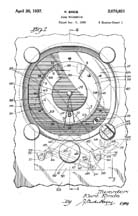
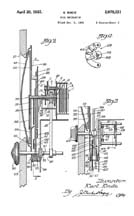
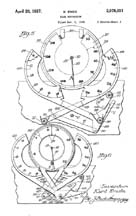
The Emde "Shutter Dial"
Patent No. 2,078,031
Click to Enlarge
Click here if you want to learn how to get Patent Drawings
The expensive console receivers of the 1930s were the equivalent of today's Home Theater systems. They were designed as "all wave" radios to cover a braod spectrum of broadcast frequencies including the low frequency local broadcast bands and the high frequency "short wave" bands. The latter were used for international broadcasts because it is possible to attain much more distance by reflecting short waves off atmospheric layers. Many listeners took great pleasure in hearing broacasts from London, Rome, Berlin and Tokyo. A considerable amount of fine classical music was available, and political news from world capitals was much sought out given the relatively limited coverage of newspapers. Also, the short wave bands allowed folks to listen in on police, fire, and aircraft radio traffic as well as time and weather information. The "all-wave" band system was somewhat analogous to today's cable programming.
Prior to Mr. Emde's invention, the various "bands" were shown as concentric circles on a dial. Mr. Emde noted that "...the wide range of frequencies covered particularly the short wave bands cannot be indicated except in a very general way and .. has little practical value.. and is confusing to the operator..." The shutter dial offers the user a number of interchangeable dial faces that give the proper detail necessary to tune whatever band was desired.

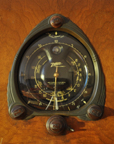

User manual Explanation of the Dial and Tone Control
Click to Enlarge
As you can see, this is a very complicated mechanism that must have added considerably to the cost of the radio. Although it is a fascinating device, its limited use probably meant that its appeal did not outweigh its cost. Low-cost radios eventually eliminated the short wave bands altogether. However, during the dark days of World War II, many people gathered around their Zenith to hear Edward R. Murrow give the blow-by-blow details of the Blitz.
Click here to look at another type of collectible, or keep on scrolling for more Radios.
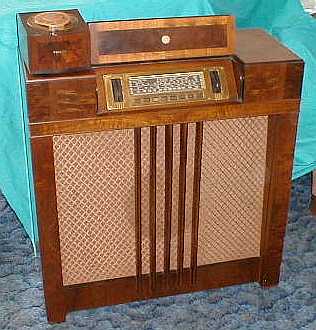
Philco Model 39-116
Posted December 15, 2008
The First Wireless Remote Control
This was "top-of-the-line" for Philco's 1939 production year. Featuring a true, wireless remote control dubbed "Mystery Control", the 39-116 used 14 tubes - eight tubes were used in the radio receiver, five tubes in the remote receiver (part of the radio receiver chassis) and one tube in the remote transmitter (which was battery operated.)
The "remote station" used a telephone-like dial that actuated a stepper unit switching between eight pre-set tuners. The "remote" was actually a small low-frequency broadcasting station. We are indebted to our reader Judy for sending in a nice photo of her "mystery control" and we have located the Patent Diagrams for this device, invented by David Grimes and Elmer Thompson, employees of Philco. (Patents 2,297,618 and 2,250,371)
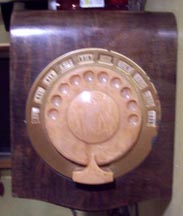
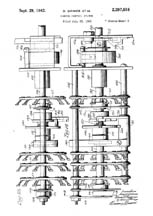
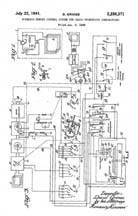
Judy's "Mystery Control" for the Philco 39-116 and Associated Patent Diagrams
Click to enlarge any photo
Click here if you want to learn how to get Patent Drawings
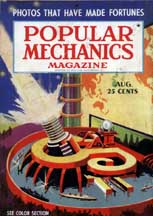

The Media and the Mystery Control
Read about it in the August 1938 issue of Popular Mechanics
Click to Enlarge
The Philco "mystery control" has a small comic relief role in the film Topper Takes a Trip. Poor Cosmo Topper is drunk again with his ghostly friend Marion Kerby, this time in an upscale deco-themed bar. Topper tries to use the telephone but instead dials a radio station, mistaking the mystery control for the telephone dial. The bartender explains how the wireless control works, because most of the folks in the audience had never seen one. The whole scene takes about 10 minutes, so this was quite a product placement coup for Philco.
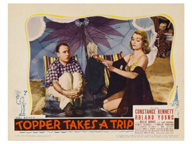
Lobby Card for the Film Topper Takes a Trip
Click to Enlarge
This was a very expensive set. The presets had to be installed by a factory technician and it took a considerable amount of "fiddling" to get the thing to work properly. In New York, rich people in the same swank apartment buildings would be annoyed when someone else's "mystery control" changed their station, as the range of the control was not limited to any one apartment. Also, the RF signal given off by faulty auto distributors could also change the channel. In addition, "Mystery Controls" were available for other appliances. We like this approach to the "smart house" circa 1939 using thechnology very similar to the RCA controller.

1939 "Smart House" Radio Control
Note the ad for the Toast-O-Lator, one of our favorite appliances
Click to Enlarge
In the 1960s, Zenith tried to solve this annoying interference problem with a wireless remote that used sound instead of RF. The Zenith remote (the "Space Command") used tuned "reeds" to produce a sound that was theoretically undetectable by humans. The receiver had similar reeds tuned to the frequency. The device controlled on/off and volume. Alas, it was found that pets could certainly hear the reeds and that parrots could learn to imitate the sound. Other remotes using light pulses (problems during daytime) were also tried without success. The remote came into its own when infrared technology was developed. HOWEVER, these were only developments in the type of signal to be used -- the basic circuits and controls within the receiver (i.e. the mechanism to step the tuner or turn the set off) remained largely unchanged in theory from the Model 39-116.
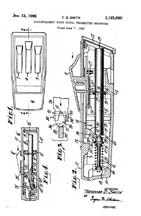
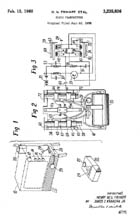
Patent Diagrams for the Zenith Space Command Remote (No.3,165,090 and No.3,235,386)
Click to enlarge either photo
Click here if you want to learn how to get Patent Drawings
Probably less than 1,000 of the Philco 39-116 sets were produced and they are museum-class rarities.
Click here to look at another type of collectible, or keep on scrolling for more Radios.

Zenith 12S267 Console Radio
Click to Enlarge
Posted October 15, 2009
The Zenith 12H267 Console
Thanks to our good friend Rachel, we have these marvelous photos of the 1938 Zenith 12S267 12 tube console radio that combines artistic splendor (an hourglass figure, no less) with cutting edge technology. Not only that, but Rachel scanned in the manual which is here for you to download.

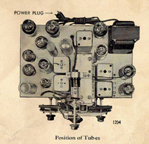
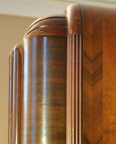
Dial, Chassis and Waterfall Details
Click to Enlarge
The set features the famous "Robot Dial" (see above) and "split second tuning" which used two indicators ("needles" or "hands") to perform the chores of gross and fine tuning. In addition to this, the set came with a Magic Eye indicator to assist in tuning. (Short wave broadcasts from abroad were popular, but very hard to tune). There is also an automatic volume control that allows you to receive high frequency sounds ("High Fidelity") or to squelch them out ("End Static"). This set even anticipates hip-hop by allowing you to boost the Bass frequencies! (Probably very popular with the "killer-diller" youth set.)
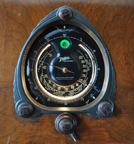
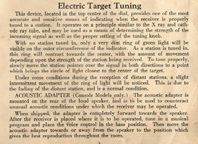
Using the Magic Eye Tuner
Click here to learn more about the Magic Eye
Click to Enlarge
You may download the manual for the 12S267 here:

Download the Manual for the 12S267
Nothing has really changed in 70 years. Here we find that Zenith has begun to offer the forerunners of "Parental Controls" and the "TV Ears".


Things To Come
Parental Controls and "TV Ears"
Click to Enlarge
Click here to look at another type of collectible, or keep on scrolling for more Radios.
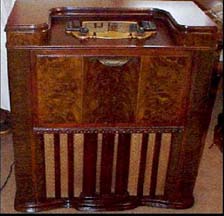

The Zenith 9H Series Zenith 9H081 Console Radio
Zenith 9H881 Console Radio-Phono - The Chippendale
Click to Enlarge
Posted February 13, 2009
The Zenith 9H Series
In 1948, Zenith introduced a new line of console radios featuoring a hide-away pull-down control drawer. This enabled the radio to masquerade as a piece of furniture when it was not being used. Comparatively few of the Radios (Model 9H081) were sold, but the radio-phono combination was a big seller. Known as "The Chippendale", the Model 9H881 featured the hide-away controls plus a hide-away phonograph.
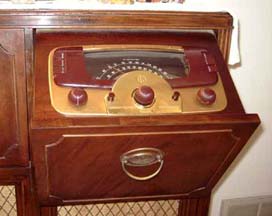
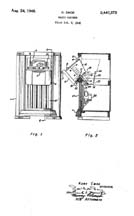
The Pull-Out Dial and Patent No.2,447,572
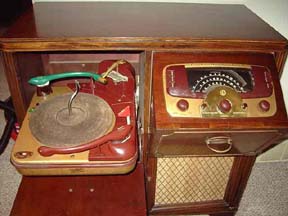
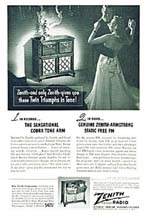
Closeup of the Phonograph with Two Tone Arms
Click to Enlarge
The Chippendale featured a turntable that used the legendary Zenith Cobra cartridge. The phono had two tone arms, a shorter one (green) for 45 rpm recods and a longer one (red) for 78 and 33 rpm records.
Click here to look at another type of collectible, or keep on scrolling for more Radios.

GE Model 201
Posted May 13, 2005
Kim's 1964 GE Model 201
These little table radios were very popular and desirable in their day -- GE and Philco had some of the best designers in the country working on them. This photo was sent in to us by our reader Kim in Colorado.
This one is special because it is not assymetric. If you look, most of the table radios radios between 1935 and 1955 have the speaker off to one side. The reason was that the old-style wooden "symmetric" radios, called "tombstones" (that's what they looked like) didn't perform all that well. The new circuits and smaller tubes that allowed plastic radios to be feasible -- and they generally split the cabinet volume with the right half components and the left half holding the biggest speaker possible (to get the amount of sound power that people wanted). Separating the speaker from the tubes was necessary because the heat from the tubes could melt the glue that held the speaker cone on (or set it on fire...)
A radio with a big speaker looking at you from the left was considered to be "powerful" -- you could take it outside and listen to the ball game while you were washing your car. [My Dad did that...] This was a big factor in making an expensive purchase. These sets were about $30 in the 1940s when people raised a family of 4 on $2,000/yr income. That $30 in 1946 would be about $600 today, so this little gadget is akin to a plasma screen TV today -- it would have been a nice luxury for a working class family.
There was an old adage in the radio business that you couldn't sell a radio with the speaker on the right side.
This little GE 201 was one of the first to break out of that mold. However, it wasn't until the mid 50s that Zenith was able to do a large business with a symmetric design in the H725 (see below).
Click Here for a picture of another collector's Model 201
Here are some photos of the back of the set. If you can't read the picture, the tube lineup is:
12S67
125A7
12SQ7
35L6 GT/G
35Z5 GT/G

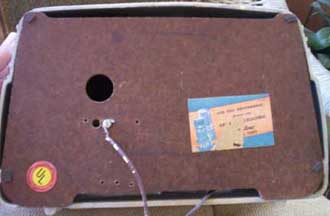
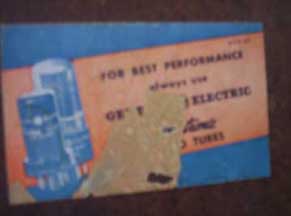
Technical details of the GE Model 201
(left) Tube Lineup for the GE Model 201
(right) Back of the GE Model 201
(bottom) "Use only GE Tubes"
Click here to look at another type of collectible, or keep on scrolling for more Radios.
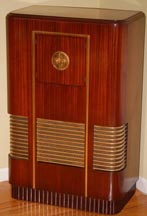
Posted June 16, 2009
Sparton Model 1476
The Sparks-Withington Co.of Jackson, Michigan manufactured radios under the trade names of "Jewel" and "Sparton", the latter formed from the first and last syllables of the company's name. (No reference to the Greek Warriors of legend). The company wasformed in 1900 by General W. H. Withington and his sons Philip and Winthrop. William Sparks, a young immigrant from England joined the company shortly thereafter.
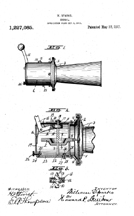
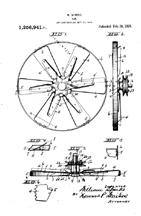
Other Sparks-Withington Products
Horn Patent No. 1,227,085,Radiator Fan Patent No. 1,256,941
Click to Enlarge
Click here if you want to learn how to get Patent Drawings
Prior to involvement with radios, the company manufactured automobile accessories (particularly horns and radiator fans).
Radio production was added to the company in 1925 under license from Roy Weagant, who formerly designed DeForest TRF sets. Sparton was one of the first to use Kellogg AC tubes. In the late 1920s, Sparton at first refused to license RCA's patents, which led Sparton into the business of making its own tubes under the Cardon brand to guarantee its supply. Sparton's Equasonne models in 1928 were another measure to avoid RCA's patents - these models used a special circuit licensed from Technidyne Corp. In 1929, Sparton finally negotiated a license with RCA - after showing that it had the capability and will to do without RCA if necessary. Once licensed by RCA, Sparton ceased making its own general tubes. In 1934-35 Sparton made the VG-1 tube also called VisoGlo, a glow discharge tube used as a tuning indicator well before RCA introduced the Magic Eye as discussed below
Sparton was not particularly successful in the radio business after 1930, but continued to produce radios and TVs until 1958, when some of its assets were sold to Magnavox. The name of the company changed from Sparks-Withington to Sparton Corp. in 1956, and it continues as a successful company today, making a variety of products in aerospace, defense, medical, and other product lines.
The most famous of the Sparton radios is the "Nocturne", immediately recognized by it's mirror casing. It has been widely reproduced at about 3/5 size, and generally the reproduction lacks the grace of the original, especially when plastic is used. The Model 1476 was extremely "cutting edge" for its time.

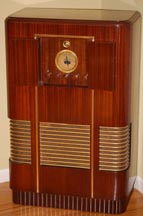
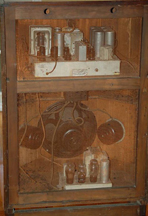
The Sparton "Nocturn" and the Model 1476
Click to Enlarge
The 1476 is a console radio and uses a 12 tube superheterodyne circuit. An additional 4 tube frequency splitter and power amplifier drives three speakers, a large electrodynamic midrange speaker and two tweeters. In addition, the VG-1 tube was used as a tuning indicator. All of this was extremely High Tech for 1935 and many years in advance of similar innovations by other companies.
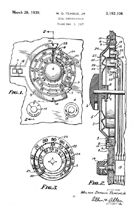
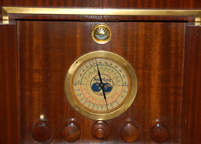

Walter Dorwin Teague Designs and the Sparton 1476
Patent for Radio Dial No. 2,152,106
, Patent for a Space Heater Cabinet, D-113,294
Click to Enlarge
Click here if you want to learn how to get Patent Drawings
Some sources reported that the Model 1476 radio was designed by Walter Dorwin Teague a famous contemporary of Raymond Loewy and Henry Dreyfuss. Teague attained a significant portion of his repute by designing cameras for Eastman-Kodak. We cannot find any definite proof that the entire radio was designed by Teague, although it is clear that Teague designed the radio's dial. The patent drawings above show a design for the cabinet of a space heater that bears a strong resemblance to the Model 1476, so it is possible that Teague designed the 1476.
It is well known that Teague designed the 1936 line for Sparton, including the legendary "Nocturne" (Model 1186, above), the Model 557, the Model 558 and the Model 409GL.
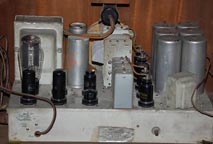
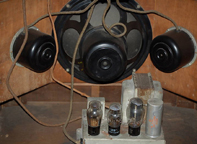
The Innovative Sound System
Left: Basic Radio Tuner, Right: Frequency filter and Speaker System
Click to Enlarge
The set could receive an astounding number of broadcast signals including Long Wave (Domestic), Three Short Wave (International and Police) and (amazingly) the Armstrong FM band. This places it at the top of its class for technological development in 1935.
Click here to look at another type of collectible, or keep on scrolling for more Radios.
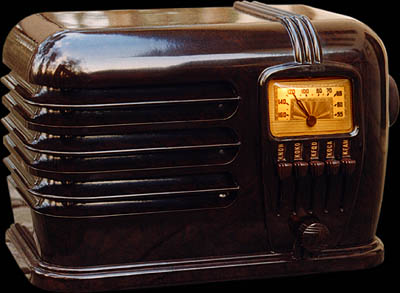
Posted January 26, 2009
1940 Belmont 636A Radio
This is a lovely little plastic radio from the period just before World War II. It has 6 tubes.
The Belmont Radio Corporation, was located at 5921 West Dickens Avenue, Chicago, Illinois. In addition to their primary product line (Belmont Radio), they manufactured sets that were sold under a variety of names such as Crusader, Classique, Freshman, Goodyear Wings, Imperial, Starck Classique, and Truetone.
This radio was designed by Richard Marholz for the Belmont Company. In August of 1938, he received Design Patent D-110,707, as shown below
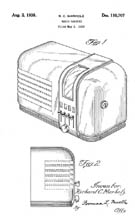
Design Patent for the Belmont 636A radio
Click here if you want to learn how to get Patent Drawings
Click here to look at another type of collectible, or keep on scrolling for more Radios.
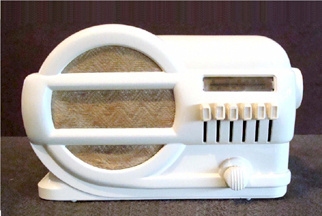
Click to Enlarge
Posted June 3, 2009
1939 Belmont 519 Radio
Here is another little Belmont Table Radio that has a whole lot of style.
This radio was designed by Richard Marholz for the Belmont Company. In January of 1939, he received Design Patent D-112,959, as shown below

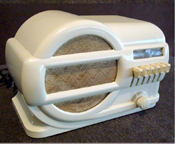
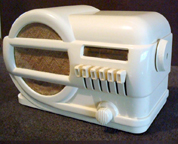
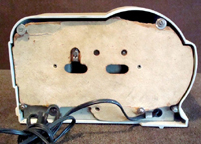
The Belmont 519 Table Radio
Design Patent D-112,959
Click here if you want to learn how to get Patent Drawings
Here are some photos of a Belmont Model 407 that were sent in by one of our readers:
_02_sm.jpg)
_03_sm.jpg)
The Belmont 407 Portable Radio
...circa 1939
Click to Enlarge
Click here to look at another type of collectible, or keep on scrolling for more Radios.

Silvertone Model 9006 Table Radio
Posted January 31, 2003
1949 Silvertone Radio
We found this lovely little AM radio at an estate sale on Mckinley Street in the District. It is in absolutely perfect shape and works very well. It is our guess that it was some kind of a gift that was put away in an attic and never played. We found it in the company of several other totally unused appliances.
Here is the tube lineup:
- 12SQ7
- 12SC7
- 12SA7
- 50L6
- 30Z6
Silvertone was the brand name used for Sears products that had been made by other manufacturers (RCA in this case). It bears chassis number 132.858. It is Bakelite and was made in 1949. Click Here for a picture of another collector's Model 9006
Click here to look at another type of collectible, or keep on scrolling for more Radios.
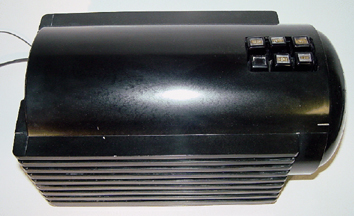
Click to Enlarge
Posted June 3, 2009
1938 Silvertone Model 6110 Table Radio
The Silvertone model 6110, better known as the "Rocket", is a particularly striking example of 1930's machine-age design. Introduced by Sears in 1938, it was claimed to be "designed for modern people living in a modern world". It appeared in their 1938 catalog with an initial selling price of $12.95. It was widely advertised in the media and could be purchased in Sears' stores for just a few dollars more than through their catalog. It continued to be marketed until late 1939, by which time Sears was claiming that it was a "sensational best seller".
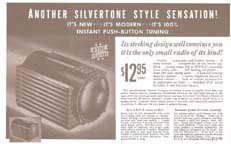
1938 Sears Catalogue ad for he Silvertone Model 6110 Table Radio
Click to Enlarge
In spite of this claim, the set is rare today, possibly because of its highly fragile housing. As a result the purchase price in today's collectibles marketplace has "rocketed" to more than one hundred times what it could be bought for when new!
The cabinet design was by Clarence Karstadt (US design patent D- 113,004). It was available in black bakelite (as here), "mottled walnut" brown bakelite and ivory plaskon. Although the "rocket" was initially offered for sale in 1938 without mention of the World's Fair, by 1939 it was billed by Sears as being "designed to reflect the architectural splendor of 1939's great World's Fair"!.

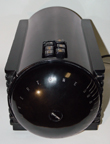
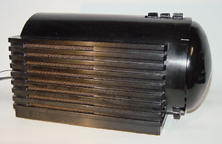
The Silvertone Model 6110 Table Radio
Design Patent D-113,004
Click here if you want to learn how to get Patent Drawings
Click here to look at another type of collectible, or keep on scrolling for more Radios.

Radio-Glo Radios Click to Enlarge
Posted June 3, 2003
1935 Radio-Glo Radio
Radio-Glo Company Inc. of , Benton Harbor, Michigan made a unique radio with stained glass side panels during the 1930s. The radio itself was undistinguished, using a 5 tube super-heterodyne, circuit and designed only to receive broadcast wavelengths. It had a permanent magnet dynamic loudspeaker. The cabinet dimensions are 13" (w) x 9.75" (H) x 7.5" (D).

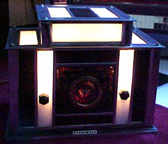
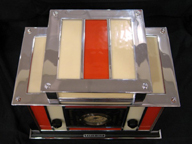
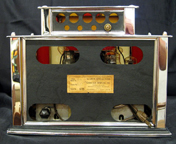
Radio-Glo Design Patent D - 101,091
Click to Enlarge
Click here if you want to learn how to get Free Patent Drawings
the cabinet was made of red and white (sometimes black and white) stained glass panels that light up with chromed metal vertical spacers and pilasters
Click here to look at another type of collectible, or keep on scrolling for more Radios.

The Kadette Topper
Click to Enlarge
Posted June 3, 2009
Kadette Radios
Years before Argus revolutionized amateur photography in America with its popular and inexpensive line of 35mm cameras, the firmís predecessors produced and marketed inexpensive and innovative radio receivers called Kadettes and Arborphones as well as cutting-edge accessories. Just as Argus was a pioneer in the world of consumer photography, International Radio Corporation, Cavac and their affiliates were pioneers in consumer radio products. Prior to manufacturing cameras, Argus had its origins in 1931 when a group of Ann Arbor, Michigan businessmen led by Charles A. Verschoor pooled their talents to give an economic boost to the Depression ravaged local economy.
Their idea was to create new jobs in a growth industry which would step up employment in Ann Arbor. Radio seemed to be the perfect answer; it was enjoying a firm hold on the American public. Verschoor formed the International Radio Corporation to manufacture inexpensive radios, using a molded-plastic case to keep costs low. The International Radio Corporation was successful from the beginning. Its initial product was the Kadette, the first five-tube ac-dc mantel radio on the market, and its patents were held exclusively by IRC.
Here are two of the most popular of the line -- the Kadette Topper, so named for its raised speaker, and the Kadette Model B a very popular radio.
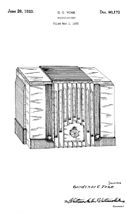
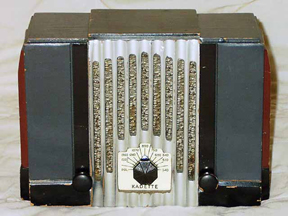

Kadette Table Radios
Design Patent D-90,172
Click here if you want to learn how to get Patent Drawings
Kadette Model B photo courtesy of Steve Sostrom
Click here to look at another type of collectible, or keep on scrolling for more Radios.
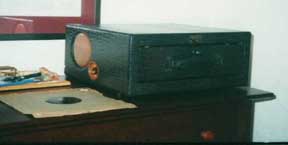
The Fabulous "Record-in-a-Slot" Philco 48-1201
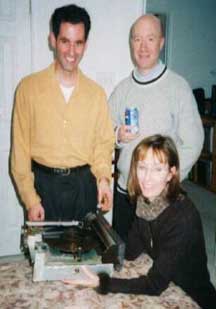
Craig shows the set to Beverley and Randy
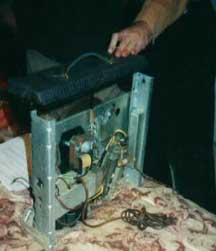
The Amplifier
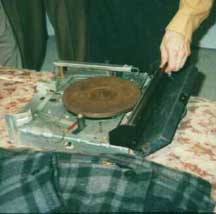
The Recrd Handling Mechanism
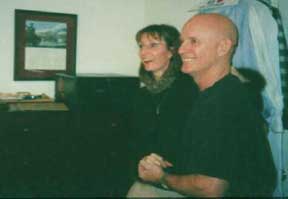
Delighted with the results!
Posted December 3, 2002
The "Record-in-a-Slot" Philco 48-1201
This astounding portable record player is the property of none other than Craig Gildner of The Blue Sky Five. Here is what Craig has to say about this wonderful device:
" The Philco is a model 48-1200. The ad I have for this model is from 1947. I have no idea how long they ran this model..and when I compared Robin's to mine, there were slight improvements in hers (motor fan integral with bushings, lip in spindle hole in turntable) which leads me to believe it was later in the production run. The actual unit pictured (sans case) is known in Philco's literature as an M-7. The first appearance of this device is 1946. I have a service manual dated as such, with a copyright of 1945. They show it being used in the Bing Crosby model radio/phonograph (46-1201, see below), and in a high end radio phonograph console. It has a 2 tube 1.5 watt amplifier, a 5" full range speaker whose frame acts as the negative lead, aluminum chassis and tonearm and a Shure crystal cartridge."

Ad for the Model 46-120
Click here to look at another type of collectible, or keep on scrolling for more Radios.

Philco 42-KR5 Radio
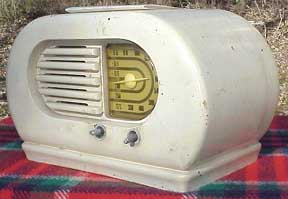
Philco 42-KR3
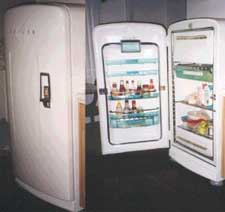
The Refrigerator that these guys sat on
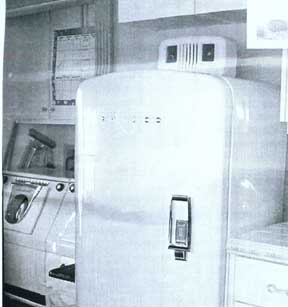
The Combination
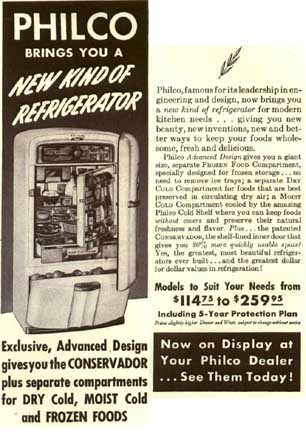
Phico Refrigerator Ad from LIFE Magazine 10-06-1941
$114.75 in 1941 is the same as $2,409.75 in 2005
$259.95 in 1941 is the same as $5,458.95 in 2005
This was the "Zero King" of the 1940s!
Posted November 30, 2002
Philco 'KR' Refrigerator Radios
This was sent by the remarkable 40s Phil in Indiana.
Phil writes: "This is a 1942 Philco 42-KR5 'refrigerator' radio. If you will notice, the bottom edge is rounded to sit nicely on a contemporary (1940s) refrigerator. Although this appears to be a plastic model, it is actually made of wood. I have forgotten the model number, but I also have a little brother to this radio that does not have a clock. The little brother (KR3) is not yet restored..." Note that these things now sell for $450 and up.
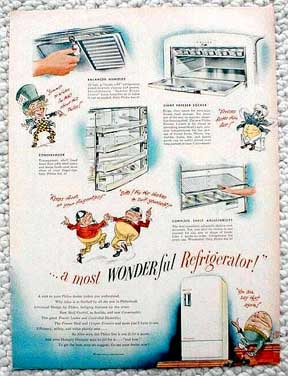
Ad for the Philco Refrigerator

Charming Kitchen Scene with the Philco Refrigerator
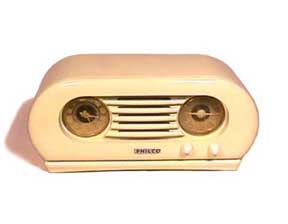
Another Collector's 42-KR5
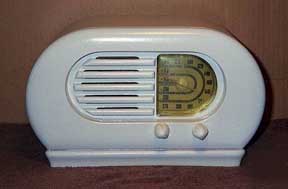
Another Collector's 42-KR3

A Bottle of Official Philco Refrigerator Cleaner
Click here to look at another type of collectible, or keep on scrolling for more Radios.
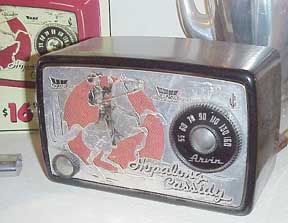
Arvin Table Model 441T Radio
Posted November 22, 2002
Hopalong Cassidy Radio
This was sent by the remarkable 40s Phil in Indiana. the Arvin model 441T featured the image of cowboy star, Hopalong Cassidy, on his horse Topper. The western motif was carried over to the metal back. When not in use, the wire antenna (the "Lariatenna") was intended to be hung from the pommel of a stylized saddle embossed on the back. This was a 4-tube set with a totally unbreakable metal cabinet, that was available in red or black. The red version seems to be commoner, but tends to command higher prices. The front is a piece of embossed and painted foil, and often shows finger wear around the knobs.
Phil writes: "The metal sign indicates that the price was $16. I bought this at an extremely 'ratty' moving/storage company in the worst section of Cincinnati, Ohio about 10 years ago. At that time I wasn't particularly interested in it but I figured I couldn't go too far wrong for ....... $4.50. It needed some electrical work and I put a new paint job on it.." Note that these things now sell for $450 and up.
Click Here to see another collector's 441T. And, Here is another. Check my page on Vintage Toys for more Hopalong Cassidy stuff.
Click here to look at another type of collectible, or keep on scrolling for more Radios.

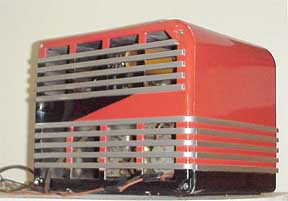
Customized GE F-40 Table Radio
Posted November 5, 2002
General Electric Model F-40 Radio
This vary rare radio was restored by one of our readers, the remarkable 40s Phil in Indiana. Phil writes: "The radio is a G.E. F 40. It was originally just brown bakelite - I couldn't resist adding the Deco paint job. Click Here for a schematic for the radio."
Click Here to see what the F-40 looked like before Phil applied his custom paint job. I agree with Phil when he says that if GE used this color scheme, they would have sold ten times as many of these radios!
Click here to look at another type of collectible, or keep on scrolling for more Radios.


General Television Model 588 Radio
Posted November 5, 2002
General Television Model 588 Radio
The General Television and Radio Corp of Chicago, Illinois made this marvelous tabletop radio, known as Model 588. An interior metal plate, which is visible from the outside, indicates that it was licensed under patents of Radio Corporation of America and associated companies and with Hazeltine Corporation. Click Here to see more radios made by the GT&R Corporation.
This set was restored by one of our readers, the remarkable 40s Phil in Indiana. Phil writes: "Here's one I'll bet you've never seen before. It's a General Television Model 588. I'm sure it's not the only one in the world, but I have never seem another one either for sale, in a collection, or in a radio book "
Click here to look at another type of collectible, or keep on scrolling for more Radios.
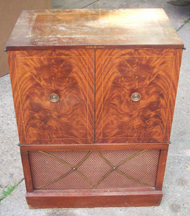
General Electric Model 749 Radio-Phono Console
Click to Enlarge
Posted July 29, 2009
General Electric Postwar Radio-Phono Consoles
The General Electric company made very few console radios and even fewer with the dial and changer hidden inside a cabinet. During the postwar period, GE focused efforts on small plastic table radios, possibly because they were aware that Television was the wave of the future and that the big mahogany thing in the Living Room would be more likely a TV and not a console radio.
Here are two examples of GE's last entries in the big ticket living room radio market.
First up is the Model 749. These photos were sent by our reader Grant in Wisconsin. The radio looks like it is in beautiful condition. It is a seven tube radio-phono combination, most likely made in 1949
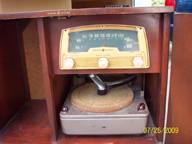

General Electric Model 749 Radio-Phono Console
Click to Enlarge
Next up is a Model 752, an 8 tube radio that features an FM Tuner. In this photograph, the changer is missing. Click Here for more information about the Model 752, which was most likely made in 1952.
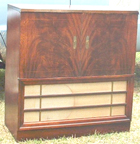
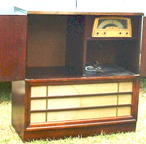
General Electric Model 752 Radio-Phono Console
This is missing the knobs and the record changer
Observe that there would be four knobs -- the 752 had a FM Tuner
Click to Enlarge
You'll note the large open space on the left, ostensibly for storing records. A Television could also go in there...
Click here to look at another type of collectible, or keep on scrolling for more Radios.
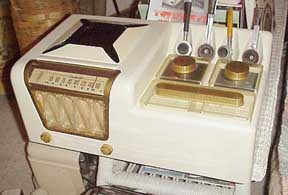

The Smokerette, Ash Tray and Radio
Posted November 5, 2002
The Smokerette Ash Tray and Radio
Smokerette (Model SR-600) by Porto Products of Chicago, Illinois. It uses a Stewart Warner radio chassis, circa 1947. It receives AM broadcasts,only and was designed by Barnes and Reinecke. Click Here to see a Smokerette in Brown. The radio has racks for up to four pipes and compartments to store tobacco, and an ash tray.
This set was restored by one of our readers, the remarkable 40s Phil in Indiana. Phil writes: "I noticed that your radio page had a combo bar/radio on it. Here's a combination of a smoke stand/radio/ashtray that you might like."
Click here to look at another type of collectible, or keep on scrolling for more Radios.

Philco Model 42-380 Radio
Posted October 30, 2002
Philco "42-380" Console Radio
This photo of a wonderful 1942 Philco console radio was sent to us by Paul, one of our readers. He writes " I just got this Philco radio model 42-380. I paid $65 for it. It's generally in good shape and the finish is fine and there is no water damage. It is missing two push buttons and there is a small tear in the grill cloth. I took out the chassis and it is all original except for the filter capacitorss and the power cord. As I look at the schematic I see it has two # 41 pentodes in push pull for the output stage all the other tubes are loctal but the 6X5 rectifier ( octal ) It has a cool dial with all the countries, two Short Wave Bands -- (a) broadcast and (b) police/aircraft "
Click here to look at another type of collectible, or keep on scrolling for more Radios.
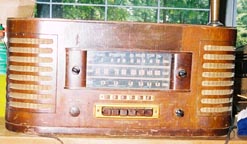
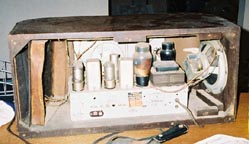
General Electric "J-61" Radio
Click to Enlarge
Posted July 3, 2002
This is another artifact from Carl Kirtley's Treasure House. The model is quite unusual in that it is symmetric, giving the appearance that it has two speakers. In fact, there is only one, in the left bay. The right bay has a loop antenna.
From what we can see, this appears to be a variant of model GE H-624. Both models share the same center design (and push button tuning). More about this will be posted soon
Click here to look at another type of collectible, or keep on scrolling for more Radios.
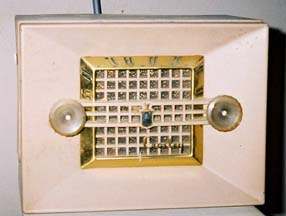
Crosley Model 11-107-U Radio
"The Decorator"
Click to Enlarge
Posted July 3, 2002
Crosley "11-107-U" Radio
This is another artifact from Carl Kirtley's Treasure House. This is also known as "The Decorator", because it was only available through interior decorators. It has a lot of style, but it is not at all different in performance or circuitry from other Crosley plastic radios of the early 1950s. This one was probably made in 1952.
From what we can see on e-bay, the Black Version seems to fetch more money. Here is another Collector's Model 11-107U And, here is the Brown Version. More about this will be posted soon
Crosley Model 547 "Fiver Quicktune"
We got this photo from our friend John who writes:
"... This is a 1937 Crosley Model 547, known as a Teletune or a Quicktune Fiver... It is restored and the AM/SW work just fine ..."
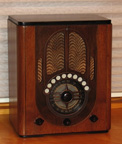
Crosley Model 547 Radio
"The Fiver Quicktune"
Click to Enlarge
John has quite a rare version. The "Fiver" means that the radio has five tubes. The "Quicktune" option worked like a telephnone dial, and option that was offered by both Sears and Philco. At the depth of the depression, people who had money would probably want to spend it on a console (with a big speaker) rather than on a souped up table radion. My guess is that the "Fiver Quicktune" didn't sell a lot of copies leading to its relative rarity. Here is a vide showing the insides of the "Fiver" without the "teletune" option. Here is a nice photo of the outside.
Click here to look at another type of collectible, or keep on scrolling for more Radios.
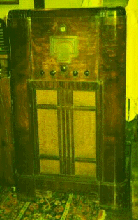
The RCA 9K2
The RCA 9K2 and the RCA 811K
RCA 9K2 Posted April 4, 2002
RCA 811K Posted July 6, 2006
Back in 2002, I posted a picture of the RCA 9K2 because it is the "Little Sister" of the Mighty 811K that we were restoring. It has taken more than four years to finish the 811K, one of the most complicated radios that I have ever seen!
This is a lower priced model that was offered a year after the 811K. It has the "Magic Eye" tuner.

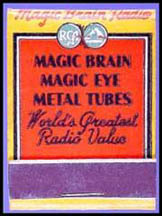
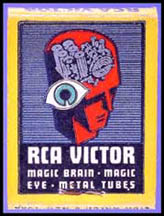
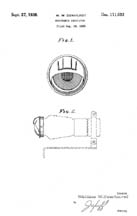
The RCA 9K2 from the back
Match Cover Extolling RCA Virtues
Closeup of the Magic Eye Sticker
RCA Magic Eye Tuner Patent D-111,533
Click here if you want to learn how to get Patent Drawings
( Click here to learn more about the Magic Eye.)
The Tube Lineup is:
- GL6
- GF5
- GK7
- GK7
- GL7
- GI7
- GH6
- SZ4
- and... the GE5 "Magic Eye"
Other photos of the RCA 9K2 may be found at:
- Randy Goodman's Radio Collection
- Freeweb Radio Pictures
Collectors Guide to Antique Radios lists the value of the RCA 9K2 at $100-$125.
The 811K is a magnificent console radio that was the top-of-the-line in 1937. It employed a whole lot of "magic" for its day:
- "Magic Brain": The receiver employs an eleven tube, three-band superheterodyne circuit that includes fully electric tuning with push button control as well as automatic frequency control. This means that the 811K had many of the functions found on today's car radios -- a "seek" function and presets, as well as circuits to keep the set tuned to the desired frequency.
- "Magic Eye": this uses the magnificent RCA6G5 tuning tube, one of the first applications of a Cathode Ray Tube (CRT) in consumer electronics -- this CRT (discussed above) is the direct ancestor of all the TV picture tubes and computer monitors
- "Magic Voice": The set has a magnificent 12 inch dynamic speaker operating at 10 Watts and 2.2 ohms. The cabinet has a parabolic rear baffle (the "Sonic Arc") to direct sound into the room.
In the July 4, 1938 issue of LIFE Magazine, RCA ran an unprecedented 8 page spread on the models that would be offered for 1939. In the upper right hand corner, you'll see the dial and controls of the 811K:

The RCA Brochure
Click Photo to Enlarge It
All of these features did not come cheap. The thing cost $692 in 1937, roughly the equivalent of a new Ford car. It was BIG -- it stands 43 inches high, is 29 inches wide and 15 inches deep. It weighs nearly 80 pounds. The cabinet is meticulously crafted, featuring four woods and six veneer styles.
For more technical details, Check out this source.
As I said, I spent nearly 4 years (off-and-on) restoring it. Here are some of the photos:
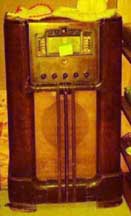
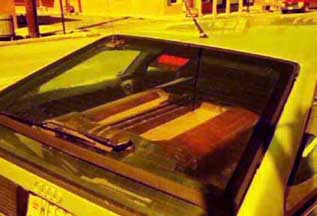
Original Condition of the RCA 811K
The RCA 811K in the Junk Store
The RCA 811K in the Back of my Car
Click to Enlarge

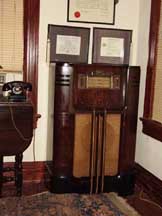
The Restored RCA 811K
The Radio in My Home Office
Click to Enlarge

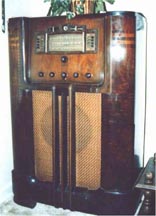
The RCA 811K
(left) The RCA 811K Dial and Pushbuttons -- The "Magic Eye is at the Top Center
(right) Another Collector's 811K
Click to Enlarge
Here is a video of the RCA 811K in action.
An 811-K appears in the film Above and Beyond, the story of Paul Tibbets, the pilot who dropped the atomic bomb on Hiroshima. Mrs. Tibbets gets the news of her husband's achievement on a well-scuffed 811-K. This is not surprising since the film was made in 1952 and the radio was probably sitting in a prop room for 15 years.
Our socks were knocked off when we got this letter from our reader A.B:
"... I do believe that I was the previous owner of the 811k in your video. I sold it about 18 years ago at a ham fest to a young couple who I believe that sold it to you. The scratches on the front of the curve are from my cat Kojak as he jumped and missed one day. To be sure that this is the same machine on the right side as you face the radio is a gouge into the finish about 2 inches long and about 1/2 inch wide that happened when I moved and something fell against it. If this is the case, I am glad to see it is still alive. B.T.W there is a KEY that goes into the tuning device on the back that slides through the two holes and is square to fit the notch in the wheel. You put the key in a hole and then turn the dial until the key drops then you tune your station and remove the key. Each slotted disk corresponds to a button on the front of the radio ..."
Not only that, "A.B." also scanned the owner's manual for the 811K which is very interesting in itself. I DID NOT know that there was an "armchair control" that could be attached to the thing. Below are the cover of the manual and the List of Accessories. We also are pleased to present the complete 811K Service Manual.

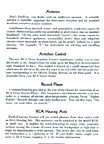

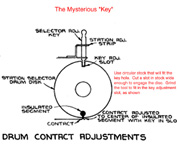
RCA 811K Documentation
(far left) Owner's Manual Cover
(next) List of Accessories
(next) Service Manual Cover
(far right) The Mysterious Key to set the push-buttons
Click to Enlarge
You can download both the Manuals right here:
- Click here to download the 811K Owner's manual
- Click here to download the 811K Service manual, including:
- Schematic
- Chassis wiring diagram
- Specifications and General Description
- Circuit Arrangement (explanation)
- Coil and Trimmer Locations and other data
- Alignment Procedure
- Socket voltages, cathode currents etc.
- Electric tuning mechanism adjustment diagram
- Electric tuning principles of operation and adjustments
- Electric tuning wiring diagram and further adjustments
- Replacement parts list
Some judicious searching revealed an ad in the August, 1938 issue of Popular Mechanics that featured not only the 811K remote but also W.C. Fields and Charlie McCarthy.

The RCA 811K Remote Control
From the August, 1938 issue of Popular Mechanics
Click to Enlarge
Not only that, we had this lengthy note from our reader Jack:
"... My grandparents bought one of these new, and as a kid, I inherited it. I had a phonograph hooked up to it and would play records, mostly 78s, through it. I had the armchair control box, which I hooked up and played with. The box used the same push button switches as the tuning buttons on the front, and used similar labels, though they were not back lit. There is a switch on the front of the radio to select remote control operation. Our radio was set up for Chicago stations, and the tuning worked pretty well. The armchair control box was brown bakelite, and was wired to the radio with a big flat cloth covered multi-conductor cable. I used to get the occasional shock from the cable, as the cloth over rubber insulation was breaking down, and I stood on a concrete basement floor. Aside from records, I was introduced to rock and roll radio on this radio, and listened to short wave broadcasts. The short wave bands produced a lot of interesting sound effects back then, as there were people transmitting images with a type of fax system that sounded like a propeller airplane if you tuned it in (see below). We used a long-wire antenna for short wave...."
"As a teenager, I dismantled the armchair remote control, as the wire insulation was at this point crumbling to dust anyway. I used the switch assembly as a keyboard for a crude electronic music synthesizer I built. I saved the box and buttons, though...."
"As a young adult, I moved the radio with me to my first apartment. It maintained an place of honor in my dining room, though by then it required replacement filter capacitors, something I never got to. I became a broadcast engineer in those days, and was working two jobs to pay for my half of a $100/month apartment. Several years later, I got married, and moved out of the apartment, but left the radio in storage in the basement of the building for a year. When I went back to retrieve it, the radio was gone. I never saw it again. I was a terrible loss, but I was stupid to think it would just stay in a relatively un-secured storage space...."
"Within the past year I saw an armchair remote box at an antique show. I knew what it was, the seller didn't. I didn't buy it, because I don't have the radio of course, and have little hope of owning one again. ..."
"On our last trip to California (we live in Chicago, drove over 7000 miles this time), I met the founder of iantique.com, an antique 'social network' site. I joined the site, and I really enjoy it. Very active, though the networking part is light, they put up lots of very informative videos. Anyway, this week I started a Antique Radio discussion group, and I'm posting pictures of some radios I've seen on the trip. There's a shot or two of a wonderful Crosley floor model there. You can join the site for free ... might be worth a look for your readers. The radio group is new, and needs some discussion! I also started a Microphone/Telephone group too..."
When I was restoring the set, I carefully saved the paper labels that were placed in little celluloid windows next to each of the tuning pre-set pushbuttons. The stations listed as presets were the most powerful broadcasters of the time. This would ensure that the owner could sit back and enjoy a [relatively] strong signal while enjoying his/her favorite programs. All of these stations are still in business today, although they have mostly changed to talk radio format. Some even have internet streaming options.
- WGN is owned by the Chicago Tribune that bills itself as the "World's Greatest Newspaper" To underscore that, in the Tribune's radio listings, the station was listed as "W-G-N", while other stations were listed without hyphens. WGN is a high-powered clear channel AM station (50,000 watts), which during nighttime hours is often audible over much of the USA, parts of Canada and sometimes as far away as Australia and South America. Early programming was noted for its creativity and innovation. It included live music, political debates, comedy routines, and some of radio's first broadcasts of sporting events, including the Indianapolis 500 race, and a live broadcast of the 1925 Scopes Monkey Trial from Dayton, Tennessee In 1926, WGN broadcast Sam & Henry, a daily serial with comic elements created and performed by Freeman Gosden and Charles Correll. After a dispute with the station in 1927, Gosden and Correll took the program's concept and announcer Bill Hay across town to WMAQ and created the first syndicated radio show in history, Amos 'n' Andy. On Saturday nights, WGN attracted a large audience for live broadcasts of Big Band music from the Aragon Ballroom.
- WBAL is from Baltimore. It began broadcasting in 1925 as a subsidiary of the Consolidated Gas Electric Light and Power Company. On January 12, 1935, with radio becoming more commercialized, there was little justification for public service company ownership of a radio station, and WBAL was sold to the Hearst-controlled American Radio News Corporation.
- WJZ began in New Jersey and became WABC. The call letters stood for their original home state, New Jer(Z)sey. It was originally housed in a shack on the roof of the Westinghouse meter factory on Orange and Plane streets in Newark, accessible only by ladder. In 1942, the FCC ruled that no broadcaster could own more than one station in a market. WJZ and the NBC Blue Network were sold In 1945, "The Blue Network" was officially rechristened the American Broadcasting Company, In November 1948, WJZ and the ABC network finally got a home of their own when studios were moved to a renovated building at 7 West 66th Street. In 1953, WJZ changed its call letters to WABC. It is unusual that my set has push-buttons for both stations
- WBZ is from Boston. In 1926 WBZ became one of the first affiliates of the first network, NBC, becoming Boston's home of the NBC Blue Network. In 1931, WBZ built a transmitter complex in Millis, Massachusetts which allowed the station to boost power to 50,000 watts. and then the station moved its transmitter site to Hull, massachusetts in 1940. The transmitter is a two tower directional array where each tower is 160 m tall. Telephone pickup of the strong AM signal is a longstanding issue in the Town of Hull. WBZ continued to be an NBC Radio affiliate, although when the FCC ordered NBC to divest of one its two radio networks, NBC kept the "Red", which simply became NBC Radio. WBZ switched affiliations from the "Blue" to the "Red" to remain with NBC. Like other major-market network-affiliated radio stations of the time, WBZ also broadcast a few hours of local programming, including Vaudeville-like musical performances from Max Zides, Tom Currier, and others, during those hours when NBC wasn't feeding programs to affiliates.
- WJR, from Detroit, began operations in 1922, owned by the Detroit Free Press newspaper, operating at 580 kHz. in 1928 the station moved from the newspaper's offices to the Fisher Building and began its callsign, "WJR Detroit, from the Golden Tower of the Fisher Building," which soon became famous across the country (and is still used to this day). Goodwill Stations Inc., formed by George A. Richards (who also owned the Detroit Lions), acquired WJR in 1929, and it became known as "The Goodwill Station" In 1931, the station raised its power to 10,000 watts; four years later, it would broadcast at 50,000 watts.
- WLW is from Cincinnati and was started in 1922 by radio manufacturer Powel Crosley Jr. and operated by the Crosley Broadcasting Corporation until the 1960s For about six years, WLW experimented with broadcasting at 500,000 watts, the first station in the world to do so. It stopped in 1939 because of complaints from around the United States and Canada that WLW was overpowering other stations as far away as Toronto. Many reports have surfaced over the years of the power fluctuations from those who lived near the transmitter. People would see their lights flicker in time to the modulation peaks of the transmitter. The signal was so overpowering it was widely reported some people actually picked up WLW radio on the metal coils of mattress and boxed bedsprings. WLW is so famous that XM Satellite radio has a separate "WLW" Channel (#173)
- WBT is from Charlotte, North Carolina The station dates to December 1920 and was first fully-licensed radio station south of Washington DC. The station had enormous reach thanks to it's unusual diamond-shaped "Blaw-Knox Tower" antennae. It boasted that it could be heard from "Maine to Miami" at night.
Here is a list of the short wave sataions that could be received in 1938:

List of Short Wave Stations in 1938
Click to Enlarge
Click here to look at another type of collectible, or keep on scrolling for more Radios.
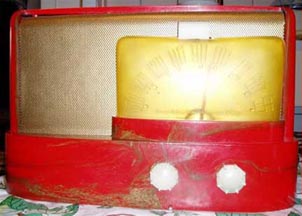
The Emerson Model 511
The "Moderne"
Click to Enlarge
Posted March 24, 2005
This radio, made in 1946, has a Bakelite Case, although Emerson also made a wood version of this design. This one is my favorite with the green-swirled Bakelite. The dial cover seems to float over the gold metallic grill, which covers much of the front. The dial cover is held on at the top top little cube of translucent ivory plastic (shown right above the dial indicator). A pilot light is hidden in this cube. When you turn on the radio, the illuminated block lights the dial.
Here is a picture of a whole bunch of moderne radios that was sent in by our reader Mark:

A Row of Emerson 511 Radios
Click to Enlarge
Mark writes:
..." I saw your picture of the Emersion 517 radio and though you could use a better picture of them. The shelf did not have room for [my whole collection] and the wooden version and the brown bakelite version are not shown. There are some radios for which the grill was painted blue instead of gold, although I believe that this was not done at the factory. The red with gold swirl and the green with gold swirl are the most sought after. The brown and black are made of bakelite and rest are made of Plaskon. The Plaskon version almost always have a 3/8" crack in the case at the front left bottom corner where the front grill meet the case. Those that do not bring very high price. The radios on the shelf are: black, white, white with gold swirl, green with gold swirl and red with gold swirl. This radio was designed by Raymond Loewy "...
Here are links to pictures of OTHER Model 511 radios:
- Antique Radio Organization
- Terry's Emerson Page (scroll through his collection!)
- WCK Page (Green Swirl)
- WCK Page (White Swirl)
Click here to look at another type of collectible, or keep on scrolling for more Radios.



Farnsworth Console Radio-Phono
Model EK-263
Click to Enlarge
Posted November 28, 2001
This gorgeous Farnsworth Model EK-263 Style-Moderne radio-phonograph console was left for junk at Dixon's Auction (nobody bid on it!) I grabbed it up and brought it home. In all fairness, it was a real wreck. I really wish that I had made "Before" and "After" photos. The turntable and radio actually work, although they have been augmented by a modern amplifier, a tape drive, an FM tuner, and a 100CD changer. This required BOTH extensive carpentry and a whole lot of electrical fidgeting.
Now, this was made by the Farnsworth Company somewhere around 1947. Why is that significant? Click here to learn about visionary inventor and businessman Philo Farnsworth. Believe me, this is worth the diversion...
The Tube Lineup is:
- 6SK7 (RF Amp)
- 6SA7 (Conv)
- 6SK7 (IF Amp)
- 6X50T (Rect)
- 6SQ7 (Det Avc, 1st Audio)
- 6V6GT (Output)
Click here to look at another type of collectible, or keep on scrolling for more Radios.
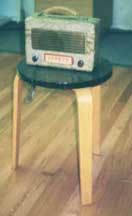
The "Empress"
The Reptile Radio
Click to Enlarge
Posted November 15, 2001
This is "The Empress", a lovely portable radio in a plywood case that is covered with a simulated alligator finish. The radio will work on either battery power or AC
This is Model 341T manufactured by the Signal Electronics Corporation, 114 East 16th Street, New York 3, new York. I believe that in the 1930s and 1940s this part of 16th street was known as "Radio Row". The set bears serial number 65154; a sticker inside indicates that the radio was made under agreements with both RCA and the Hazeltine Corporation.
The Tube Lineup is:
- IR5
- IT4
- IS5
- 3S4
Click here to look at another type of collectible, or keep on scrolling for more Radios.
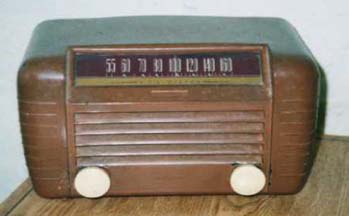
RCA Model 65X2 Table Radio
Click to Enlarge
Posted November 15, 2001
This is a small bakelite table radio, RCA model 65X2. The original color is white, and someone has (badly) applied a dark spray, possibly to make it look more like Bakelite. This case will require a lot of patient effort working with vaseline and steel wool to remove the junky paint. Watch this space in about a year to see the finished product...
This radio is distinguished for two reasons:
- In the very first scene of The Maltese Falcon, the camera moves from a panoramic view of San Francisco, through the windows of the offices of "Spade and Archer" and on to Sam Spade (Humphrey Bogart) rolling a Bull Durham cigarette. You can see the RCA 65X2 clearly in the background!
- In the Disney retro flick The Rocketeer (which is FILLED with references to all sorts of fabulous things), the hulking henchman Lothar is seen listening to a 65X2. (Lothar himself is a skilled recreation of Rondo Hatton, also known as "The Creeper" a legendary B-movie bad guy)
Click Here for a picture of another Collector's Model 65X2.
This simple Superheterodyne AM set bears serial number B206565, Chassis number RC1064 B 274. The Tube Lineup is:
- 50L6GT
- 12SQ7
- 12SK7
- 12SA7
- 3525GT
Click here to look at another type of collectible, or keep on scrolling for more Radios.
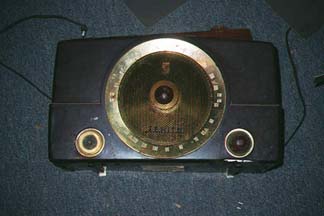
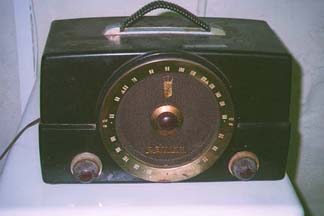
Zenith Model H725 Radio
Click to Enlarge
Posted June 15, 2001
I found this wonderful Zenith Model H725 radio from the 1950s at a thrift store in Front Royal. It has an unusually big speaker and a great tone for old-time Rock 'n Roll. The "Dagmar" knobs are quite distinctive --- and it has an FM tuner, quite an expensive item in its era. This type of radio is somewhat common; however, there is a radio-phonograph combination with this same design that is exceptionally rare and valuable.
Click here for more photos from the 725 series. Here is the design patent for this series:
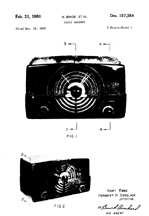
Karl Emde's Design Patent D-157354 for the 725 Series
Click to Enlarge
Click here if you want to learn how to get Patent Drawings
When I got the radio, it was encrusted with grime and covered with mildew. My guess is that it spent a lot of its life in a garage, and then was relegated to a humid basement. The cleanup was effected with very fine (#0000) steel wool and Vaseline --- very carefully and slowly apply the vaseline and rub in small circles without much pressure. The petroleum jelly will slowly dissolve the grease without removing the paint. I had to make a tuner needle out of brass stock
The Chassis number is 7K01. There is a code number 317787 on the back, which may be a part number or a serial number. Here is the Tube Lineup:
- 6BJ6
- 12AT7
- 12BA6
- 12WL6
- 19C8
- 35C5
Click here to look at another type of collectible, or keep on scrolling for more Radios.

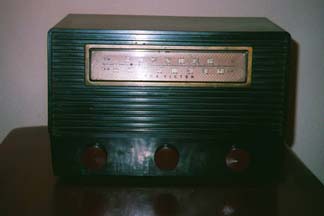
RCA 8X71 Radio
7 Tube AM-FM Receiver made in 1949
Click to Enlarge
Posted June 15, 2001
This radio turned up at a yard sale
This radio was made in 1949, and all it needed was a little cleaning. The Bakelite knobs are very nice, and it has a great sound. This radio also has both AM and FM circuits. I suspect that this is much earlier than the Zenith radio above, because a sticker on the base gives extensive instructions about preparing an external antenna.
Of note, there is also another sticker that says the following:
includes the matched elements
required in the production of
Golden Throat Tone"
(signed)
D.D. Cole
Chief Engineer
Instrument department
RCA VICTOR
Take a look at the Advertisement below to get a feel for the "Golden Throat Tone" advertisement campaign. D.D. Cole was right --- this set does sound VERY good for all kinds of music. I am impressed!
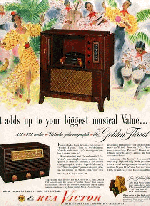
1949 Advertisement for the RCA 8X71
for another photo of an 8X71 in another collection.
Here is the Technical Detail
Model 8-X-71
Superheterodyne
Range:
AM 540 to 1600 KC
FM 88 to 108 MC (Post Armstrong Era)
Serial B016704
This 7-tube set bears serial number B016704. The Tube Lineup is:
- 19J6
- 6BJ6
- 35C5
- 6AQ6
- 35W4
- 12AV6
- 12AL5
Click here to look at another type of collectible, or keep on scrolling for more Radios.
RCA K-60 Console Radio [ca 193]
We saw this radio at Mamie's an "Old-Timey" restaurant in Aberdeen, Maryland. The place serves lots of good old American cooking at low prices. A decidedly nice place to visit, made even better by a fairly large display of artifacts from the 1950s.

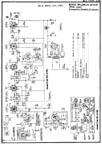
_sm.jpg)
The RCA K-60 Console Radio
The radio at Mamie's could use some help with the grill cloth
Click to Enlarge
This is a 6 tube console radio that is fairly undistinguished, save for the FM Tuner. The version at Mamies could use some help with the grille cloth. The photo also shows a Big Ben alarm clock on top of the radio. This was designed by Henry Dreyfuss. See our Clocks Page for further details.
Here is a VIDEO of the RCA K-60 in action:
Click here to look at another type of collectible.
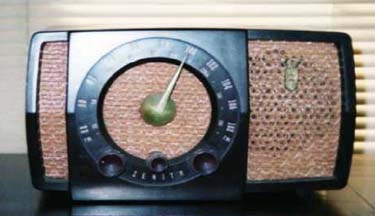
Zenith R723 Table Radio
Click to Enlarge
Posted January 10, 2002
This is a very nice AM/FM radio that I found in a thrift store. It works perfectly, so I have not had to so much with it. It dates from about 1953. The back of the radio indicatesthat the set was serviced at Potomac Valley Electronics, 6901 MacArthur Blvd, Washington, DC. The phone is OL-4-5140.
Click here for more photos from the 725 series
This model has Chassis 7H0422, and draws 30 watts. The Tube Lineup is:
- 6BJ6
- 12AT7
- 12BA6
- 12BA6
- 12AU6
- 19T8 or 19C8
- 35C5
Click here to look at another type of collectible, or keep on scrolling for more Radios.
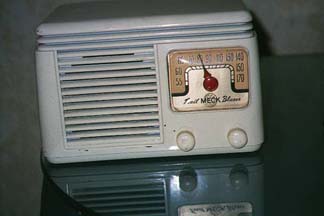
Meck Table Radio
The "Trail Blazer"
Click to Enlarge
This lovely little five tube radio was made by John Meck Industries Inc. of Plymouth Indiana in 1948. This is Model 5E7/x-12, Serial number 385211. It draws 35 watts and works just fine. Alas, AM only.
Click here to see a "Cousin" of the 5E7 in another collection --- this is the 5A7 and it has a Handle. Click here to see how the collector restored this radio.
Click Here to see the same radio in brown from another collection. Click here for yet another photo from another collection (this is a popular little set...)
The Tube Lineup is:
- 14Q7 (12BE6)
- 35Y4 (35W4)
- 14A7 (12BA6)
- 14B6 (12AT6)
- 50A5 (50B5)
Click here to look at another type of collectible, or keep on scrolling for more Radios.
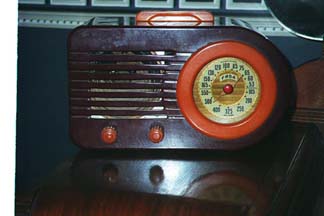
FADA Model 1000 Table Radio
Frederick A. D'Andrea
Click to Enlarge
This is the very famous Model 1000 table radio made by the FADA Corporation on Long Island. This is the quintessential icon of 1940s design in radios that appears in widely in books. This is probably the most desirable of all Bakelite table radios. Specimens in good condition can fetch over $2,500. The name "FADA" is derived from the initials of the brilliant electronics engineer, Frederic Anthony D'Andrea. During the 1950s, D'Andrea television sets were widely held to be the absolute best available.
This model was made in 1946. It has a simple 6-tube superheterodyne regenerative circuit --- in other words, it is a normal garden variety AM radio. It is fairly selective, better than a Zenith of the same period that I have. The interest is in the case, not the quality of the radio reception. The case is made of Catalin, a trade-marked method casting phenolic resin plastic without the high pressure required to make the sister product Bakelite.
Here is the Tube lineup:
- 12SA7
- (2) 12SK7
- 12SQ7
- 35L6GT
- 35Z5GT
Click here to view a 1946 Fada Radio Advertisement
I found this in a junk store in Denver in 1979 and paid about $3 for it. The burgundy and butterscotch color scheme is my favorite of the lot, although they came in a wide variety of colors. White and Butterscotch is also a desirable color scheme. It still works.
Here are more of these gorgeous babies:
- All Butterscotch
- 1946 Butterscotch and Red
- Butterscotch and Brown
- Alabaster and Red
- All Butterscotch
- Maroon and Butterscotch
- Lime Green with red swirls and Butterscotch
- Butterscotch and Red
Click here to look at another type of collectible, or keep on scrolling for more Radios.
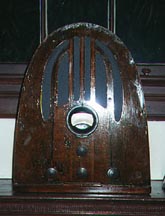
Philco Beehive Radio
HENRY! Henry Aldrich! Click to Enlarge
This is the classic Philco radio, symbolic of that which was in the homes of thousands and thousands of Americans during the 1930s. This particular model was made in 1937 and has the designation Model 37-60B. We can just imagine the soft golden glow of the dial in a darkened room as folks gathered around the set to listen to "The Green Hornet" or "Fibber McGee and Molly" or maybe to hear the results of the Lindbergh kidnapping trial or the Hindenburg disaster. Perhaps this radio actually broadcast Orson Welles' "War of the Worlds" program and its original owners got scared out of their wits.
I got this radio in Charlottesville in about 1972. It spent a part of its life in the Billiards parlor out behind Eljo's and I picked it up for about a dollar in the auction when the place closed. That's another story... (actually, the Charlottesville Billiards parlor is memorialized in Installment 13 of The Serial)
The problem with these Philco radios is that the elaborate burl inlay on the face is not really wood --- in fact, it is varnished paper. Over time, the paper deteriorates. In order to restore it, I had to use a very thin brush and draw in the missing detail. This was a VERY tedious process! And, you have no idea how difficult it was to find authentic parts for the radio.
Here is some technical detail from the label:
Code 121
115 VAC 50-60 Cycles 60 Watts
39-4759
Cabinet: part 10226A
The Tube Lineup is:
- 6A8G
- 6K7G
- 6Q7G
- 5V4G
- 6F6G
Click here to look at another type of collectible.
Bosch Radio Globe
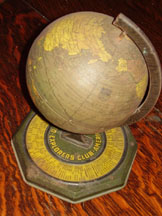
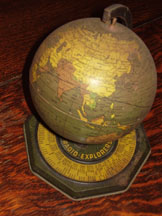
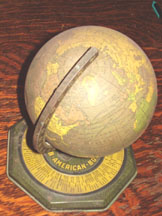
J. Chein Pressed Tin Bosch Radio Globe
Click to Enlarge
The Chein company made a lot of promotional gifts from other companies. This is a globe made for the Bosch Radio Company. In the early days of Radio, listeners were eager to listen to far away stations, especially on shortwave. Receivers with a shorwave band were quite expensive, and this little globe may have softened the pain, because it admitted one to the Bosch American Radio Explorers Club. The call leters of various international stations are printed on the base for reference. The globe is definitely from before World War II, because (middle picture) it shows "Indochina (Fr.)" in southeast Asia (eventually, after more than 30 years of war, this became Vietnam, Cambodia and Laos). Also, you'll note "India" is one country, no Pakistan or Bangladesh. On the left picture, you'll note that Korea is shown as part of Japan. Old globes are very interesting.....
Click here to look at another type of collectible.
General Marshall's Radios
George Catlett Marshall (December 31, 1880 Ė October 16, 1959) was an American military leader, Chief of Staff of the Army, Secretary of State, and the third Secretary of Defense. Once noted as the "organizer of victory" by Winston Churchill for his leadership of the Allied victory in World War II, Marshall served as the U.S. Army Chief of Staff during the war and as the chief military adviser to President Franklin D. Roosevelt. He served as Presidnt Truman's special emissary to mediate the conflict between the Communist and Nationalist forces in China. As Secretary of State his name was given to the Marshall Plan, for which he was awarded the Nobel Peace Prize in 1953. General Marshall is on most historians' short list of the Greatest Americans Ever.
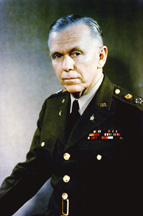


General Marshall and Dodona Manor
General of the Army, Seretary of State and Defense, Nobel Laureate, radio collector...
Click to Enlarge
From 1941 - 1959, General Marshall and his wife lived at Dodona Manor on Leesburg, Virginia. The house was constructed in the mid-1820s for John Dirsh. The house soon passed into the possession of the Ball family, who added an addition. There is evidence that the building served as a female boarding school in the 1850s. The Marshalls bought the house in 1941 and lived there until 1959. It was declared a National Historic Landmark in 1996 and is open for tours. Of interest are two radios that belonged to the General.
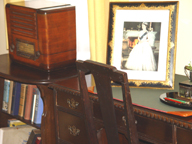
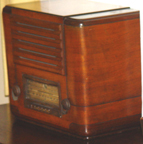
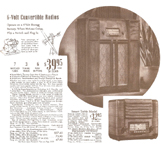
Genral Marshall's Silvertone Radio
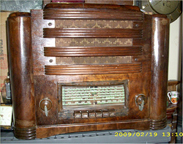
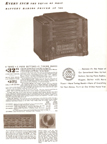
1939 Sears Catalogue Ad for the Model 6363 Silvertone Radio
Silvertone was a Sears brand name
Click to Enlarge
This mahogany table radio is of some interest - it is a Silvertone (the Sears Brand) Model 6368, sold in 1940. This radio is somewhat unusual in that it was sold as a "convertible". It could work with either AC current or off a battery. The ad (above) says that it can operate on the 6 volt system charged by wind power -or- "When Hi-line comes, flip a switch and plug in." This could also have been of interest to General Marshall, because it could also be used when he was on maneuvers with his troops. This radio has a six band dial which means that Gen. Marshall probably listened to short wave accounts of World War II on the BBC on this radio. The radio has push-button tuning and a GT5 "Electric Eye" tuning tube.
The radio has the speaker on top and the dial below. Collectors call this a "tombstone" design. This arrangement exposed the speaker to the heat of the tubes and could have some distortion if the set was "on" for a long time. People found the design "top heavy" and you don't see many tombstone radios made after 1940. This version is quite rare -- probably because the relatively small amount of grille spaces for letting heat escape may have resulted in most examples of this model being junked. I have found no other photos of this radio.
However, I was able to find a photo of a Silvertone Model 6363 from the 1939 catalogue that was set up to run on batteries for a farm. It looks like somewhere down the line, half the grille bars were removed.
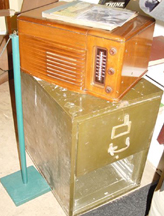
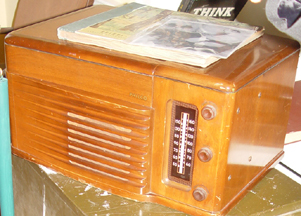
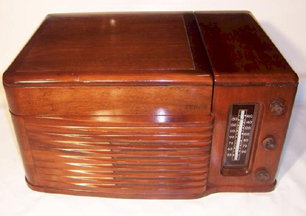
General Marshall's Philco Table Radio
After retirement, he probably listened to baseball games on it..
Click to Enlarge
The radio shown on top of a file cabinet is a Philco Model 48-1256. It was made in 1948 and is a good, sturdy useful radio with no unusual features.
General Marshall also had a 1947 model TV set that is on our Vintage Television Page. The kitchen at Dodona Manor is full of marvelous artifacts from the 1940s and 1950s that are discussed on our Retro Kitchen Page.
Click here to look at another type of collectible.
The Business of Selling Radios
In the decade 1929-1939, Radio was a BIG Business. At that time, there was no Bigger Business than Sears Roebuck. We have been fortunate to get hold of Sears mail-order catalogues from that decade, and we hereby present the radio advertising pages for your enjoyment. Be warned, however, that there will be some math later on as we take a look at that the penetration of technology into Mass Markets. You will have some deja vu moments if you got stuck paying $1,000 for one of those cellular_phone-in-a-bag things (or the $700 i-phone...)
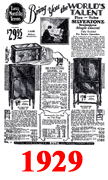

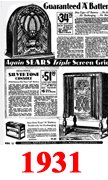
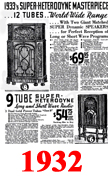
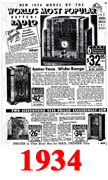
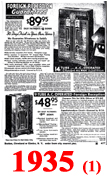
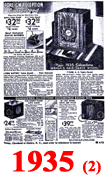
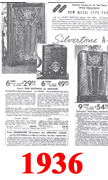


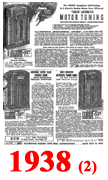
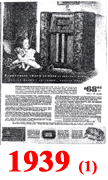
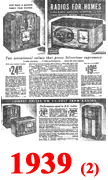
Sears Radio Ads from the 1929-1939 Catalogues
Multiply the prices in the ads by about 30 to get the equivalent in 2009 dollars
None of these were "cheap" - they are like a flat-screen TV in the 21st Century
Click to Enlarge
These advertisements cover a period in which Radio evolved at a frenetic pace, much faster than any technology before or since -- personal computers and cell phones required almost 20 years to penetrate the market to the degree that Radio did in 10 years. In 1929, radios are expensive, don't perform very well, and speakers are optional. By 1939. radios are offering connectivity to television "... when it does come ..."
Radio development in the decade focused on four factors
- Range: Short-wave broadcasts could travel around the Earth. Many countries offered news (often in English) and music without commercials. Some programs (particularly in England) became popular in the US through shortwave. Later, war news became very importsnt. This required a substantial investment for a radio capable of receiving these stations. Only the relatively wealthy could enjoy these broadcasts, a direct parallel to today's households with and without cable. If you are a fan of AMC's Mad Men show, you may have noticed some surprise on the part of your friends without cable when you declaim on this subject. Imagine the same reaction your grandparents may have had in 1936 when their friends had not heard the front-to-back broadcast of the Olympic Games in Berlin. You'll see ads touting new circuits that improve range, using words like "Superheterodyne", "regenerative" and the like.
- Tuning: Even if the set was capable of receiving distant broadcasts, tuning was a major chore because almost any atmospheric distortion could cause the set to lose the station. In addition, many stations were spaced closely together. Almost none of you remember television sets with "fine tuning" controls -- or the need to put aluminum foil on the rabbit ears. The closest that we can come to an analogy for this is the evolution of the Remote from a "nicety" to a "necessity." You'll see that a major focus of ads is on ease of tuning. This runs from "thumb wheels" of 1929 to "magic eye" tuning aids to Push Button controls and automatic frequency-keeping.
- Power: It's American to want the Biggest, and radios came to be sold by the number of tubes at the same time that cars were being sold by horsepower. More tubes meant Better, although few Americans could actually explain why this was so. In general, "tubes" are used for amplifying signals, although later developments allowed them to perform logical functions (just like the things in computer chips). Thus additional tubes were used to separate frequencies for tone control, or to keep the set locked on a specific frequency. All of this use of electrical components to perform a variety of functions is very much akin to the use of computer chips to allow a cell phone to be a camera, music player, etc.
- Style: Radios in the period 1929-1939 were high status possessions. Console radios with lots of features cost a lot of money, equivalent to $2,000 and up in today's dollars. It was necessary, then, for such a large purchase to be housed in a suitable package as to convey the status associated with it. Thus, you'll find that the ads pay a lot of attention to the "Modern Styling" and elaborate veneers used in constructing the cabinets. The best analogy to the 21st centure would be the Home Theater System. In fact, many of these expensive console radios were not that well made. Since technology was changing rapidly, mass marketers like Sears used paper capacitors and resistors that went "off-spec" in a few years, causing an annoying hum or long warmup times. Extensive heat from the tube weakened solder joints making it possible to "fix" noises by smacking the top of the radio... However, the family had spent so much money on the set that it could not be discarded, even though (like your Pentium II computer) it was virtually worthless. The valuable item eventually went into the basement where it sat for 60 years awaiting restoration. There are LOTS of console radios available.
Our investigation of the price data has revealed some interesting facts. First of all, we'd like to comment on Installment Sales and deceptive advertising. You'll note that the Sears ads are full of talk about an "Easy Payment" plan ("$5 down, $5 a month") that are eerily reminiscent of today's Infomercials. You'll also note that the advertising copy touts each and every product as the greatest thing since sliced white bread. We'd like to alert you to the "Fine Print":
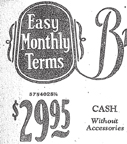
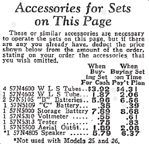

Big Print and Fine Print
The big print price is without the tubes!
Click to Enlarge
The first observation is that the "Low,Low Price" for the radio does not include the tubes, something akin to selling a car without the motor. In fact, when all the "accessories" are added up, the price almost doubles from $29.95 to $58.95. Any of you who have bought a car based on the advertised price will not be surprised that the "add-ons" multiply like rabbits.
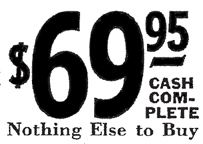

Full Cost Pricing and the Consumer is Our Pal
"Saving" the Consumer from their own previous deception
"Sears do not Experiment..." [sic]
Click to Enlarge
Sears continued this practice untill 1933 when public opinion forced them to start saying "nothing else to buy" in their ads. periodically, Sears would also insert blurbs that indicated that they were looking out for the little guy, as shown above. Parenthetically, Sears advertising copy is reputed to be the most effective prose ever written, maximizing meaning while minimizing words. The copy editor must have been asleep when the "metal tubes" ad was written.



Analysis of the Deeper Meaning in Sears Marketing
Click to Enlarge
With the vast increase in Consumer Credit in the 21st Century, most folks have finally become conversant with the term "Annualized Percentage Rate" or APR. Federal Truth-in-Lending laws may have helped. There was none of this around in the 1930s. One might wonder about those "$5 Down and $5/Mo" schemes and what Truth in lending would have to say. We did just that. Until 1935, all the data required to compute APR were right there on the ad. After 1935, Sears determined that folks could do the math, so they made it a little bit harder, referring you to an obscure "easy credit" section in the back of the catalogue. They had good reason to hide the data! As the table above shows, they were lending money at APR ranging from 12% to 23% ! Buyers of console radios got the best deal at APR in the vicinity of 13% -- this when you consider the prime rate as at about 2%. Sears was not a liberal lender -- you had to pass a fairly stiff inspection if you were going to get goods on an installment plan. Table radios had APR of over 20%, so it seems that Sears made it easier to buy a big item on credit than a small one. Close analysis of APR indicates that Sears was willing to give much lower terms on obsolete items (in order to get rid of the stuff...) So, if your credit card statement gives you agita you can be somewhat comforted by the fact that your grandparents faced the same dilemma. Sears probably made more money off credit (lending for short terms at astronomical interest) than they did on their goods.
It is hard to get comparable data, but some rough analysis of the information in the 1929-1939 catalogues indicates that the price of the radio was strongly correlated with the number of tubes. Each tube added about $7 to the retail cash price, something that would be equivalent to about $210 in 2009. This might be comapred to the cost of each gigabyte (or terabyte...) of storage in today's computers. To give you a little idea about competition based on "tubes" here are a few ads from the 1930s:
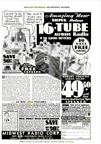

Tubes! Tubes! Tubes!
Midwest Radio Ad, Popular Mechanics February, 1934
Scott Radio Ad, Popular Mechanics September, 1936
Click to Enlarge
The largest radios offered by "Major" manufacturers had 18 tubes (e.g. the Zenith Stratosphere series) and were quite costly, some in the neighborhood of $600 in 1930s currency. The Scott Ad (left) promises a whole lot for 1934 including automatic tuning and a volume control that kept the sound level constant as you changed from station to station. If the illustration is accurate, the thing must have been 6-8 feet tall! If the performance came anywhere close to that touted in the ad, it was a bargain at $49.50 (about $1,500 in 2011 dollars)
The forty tube wonder offered by the Scott Company (right) has to hold some kind of record for size and weight. The 40 tubes were spread around doing the amplification and frequency separation for those five speakers
Since technology and features were changing rapidly, it is hard to see cost trends. The only place where some analysis is possible is in the area of battery powered farm radio consoles (see next section, below). Basically, it was almost impossible to get enough current out of batteries to support anything bigger than six tubes. So, the 6 tube circuit became standard for farm radios. As shown in the graph above, costs fell precipitously over the period 1929-1939 -- just like the prices on computers, flat screen TVs and cell phones did in the 21st century.
So, there you have it -- Abusive lending, deceptive advertising, rapid obsolescence. Nothing has changed, has it?
Sears Farm Radios [ca 1939]
Nothing is new under the sun -- wind energy was powering radios on farms from the 1920s up until the 1950s

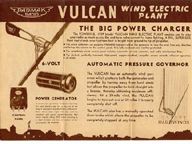

The Market for Wind Turbines was Competitive in the 1920s and 1930s



There are Literally Hundreds of Wind Turbine Patents dating back to 1850
Wincharger Governor Patent No. 2,207,964
Parmak Governor Patent No. 2,074,952
Parris-Dunn Patent No. 2,178,047
Click to Enlarge

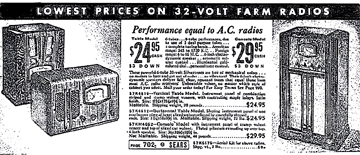
The Wind Turbine Was Used to Provide DC Current for the Radio
All of the Big Mail Order Houses sold "Farm Radios"
Click to Enlarge
If there wasn't a whole lot of wind, you had another option: a gasoline powered generator

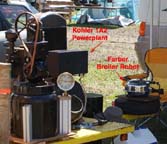
Combustion Alternatives to Wind Power
(left) The Sears Power System
(right) The Kohler 1A2 Power System
Click to Enlarge
The primary motivation for installing the Wincharger was simply to listen to the radio. In the 1920s, radio sets were pretty inefficient ant required a lot of current to keep those big tubes working. If you didn't have electic service, you needed a BIG Rack of 6 volt batteries -- just like the ones that were used in cars back then. (Since the 1960s, we have moved on to 12V automotive systems). Thus, having a radio meant that you had to keep the battery charged. Along the way, you had to pick up a few accessories....
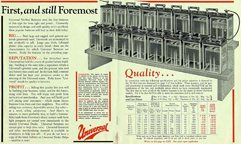
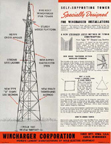
"Accessories" for Do-It-Yourself Wind Power
The Universal Battery System
The Wincharger Tower System
Click to Enlarge
You had to erect a fairly substantial tower and climb up there to tinker with the mechanism. If you ever harbored thoughts that the farmers of the 1920s were lazy rubes, forget it. The tower (and generator) came in a box, and the farmer had to erect it, keep it running -- including climbing back up the tower after a major storm to fix whatever damage had been done..
Was this a hobby of a few "trendy" farmers of the 1920s? Not at all -- there were a fair number of competitors in the market and all major manufacturers produced household and farming appliances that could be run on the DC current generated by the windmill. You'll note that both Wincharger and Vulcan went into partnership with radio companies. For a while, if you bought a Zenith console radio, you got the Wincharger (less tower...) for free.
The Dunn system illustrates one of the major problems with wind generation -- something that still plagues even the most modern versions. If the wind has too much force (e.g a violent thunderstorm) the blades of the propellor or the bearings will be damaged. Every wind generator has some kind of governor change the angle of the blade so that they stop when the wind speed goes above a certain point. The Wincharger used sliding weights, and the Dunn system uses springs. Modern wind turbines have computer controls to "feather" (change the angle) of the turbine blades. All are really vulnerable to Tornadoes and Hurricanes
So, why has America's mass involvement ith wind-powered distributed generation totally absent from the history books? The answer is simple, once the Rural Electrification Administration (REA) came to the farm with reliable AC current from the power company, the farmers GLADLY stopped climbing the tower and fiddling with the acid in the batteries. They switched on the lights, read their paper and let a milking machine take care of the cows without ever having to worry that the current would flicker out -- or that their expensive generator would get blown off the tower.
Click here to look at another type of collectible.
Sears Silvertone M-1535 Console Radio [ca 1931]
This is an early console radio from the tim at which AC power was an expensive add-on due to both the size of transformers to convert AC to DC and the general lack of reliable electricity service in large parts of the country. Electricity was very expensive and many people found that it was cost-effective to use a battery. In the same ad, Sears sells a "One Year" battery for $7.95 (about $240 in 2009). The closest analogy for the 21st century would be prepaid cell phones or debit cards. These give people the ability to control total cost without worrying about monthly bills. Dad could buy one battery and if the kids used it frivolously playing the radio at all hours, then it would be too bad... but he wouldn't get socked with a surprise monthly bill.


Silvertone M-1535 Radio
$51 in 1931 is equivalent to $1,300 in 2009 dollars
BUT -- that's without the tubes! Add another $22 ($600) if you want it to play
Click to Enlarge
The M-1535 was sold during the period when tubes sold separately. The full cost of the M1535 is $73, almost 50% more than the "base" price.
Click here to look at another type of collectible.
Sears Silvertone M-1670 Console Radio [ca 1933]
The Model 1670 represents a great advance -- domestic (long wave) and international (short wave) reception is offered in a single unit. In order to tune both bands, the manufactureres (Colonial Radio) came up with something they called a "Micro Vision" dial. That meant that it worked like a Micrometer, not that it would enable you to see small things.

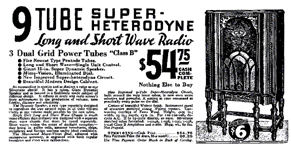
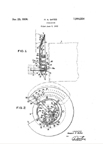
Silvertone M-1670 Console Radio
Patent No. 1944554 for the Micro-Vision Dial Mechanism
$54.75 in 1933 is equivalent to $1,650 in 2009 dollars
This one came complete ... nothing else to buy
Click to Enlarge
Click here if you want to learn how to get Free Patent Drawings
This is also the first year that radios were sold "complete" -- tubes and all.
Click here to look at another type of collectible.
Sears Silvertone M-1808 Table Radio [ca 1935]
This is a slightly upgraded version of the 1934 "Worlds Fair" radio that "sort of" looked like a skyscraper. It was heralded as the "New 1935 Silvertone Worlds Fair Model." It was available in Battery and Ac power and featured a two-speed dial and automatic frequency control

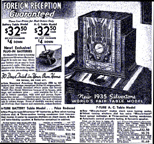
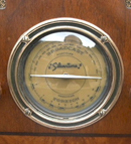

The M-1808 Table Radio
$32.95 in 1934 is equivalent to $930 in 2009 dollars
Click to Enlarge
The front awas finished in "carefully matched Waalnut and Madrone Burl veneers.."
Click here to look at another type of collectible.
Sears Silvertone M-1831 Console Radio [ca 1935]
The Model 1831 is a 9 tube console radio that was the middle of the line for 1935. It had one speaker when high end versions were experimenting with two speakers.
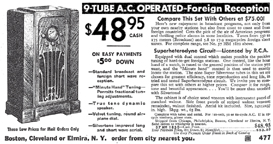
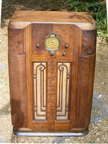
Sears Silvertone M-1831 Console Radio 1935
$48.95 in 1935 is equivalent to $1,500 in 2009 dollars
Click to Enlarge
Of note, the ad is careful to note that the superheterodyne circuit used in the M-1831 was licensed under the RCA patent. By 1937, Colonial Radios, makers of the M-1831, had patented their own circuit.
Click here to look at another type of collectible.
Sears Silvertone M-1938 Table Radio [ca 1936]

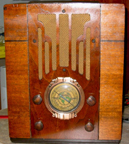
The Sears Model 1938 Table Radio
$19.95 in 1935 is equivalent to $600 in 2009 dollars
Click to Enlarge
The Model 1938 table radio was a 6 tube superheterodyne set that tuned tha American Broadcast Band (540-1600KC, the American Short Wave band (1580-5100 KC, and Foreign Short Wave 5.8-15.5 MC. The ad says "At these prices, there's no need for you and your family to MISS the BIG THRILLS of Radio." In 1936, many folks worked for a lot less than $20 a week. This set had a lot of features that were nominally comparable to much more expensive brands like Philco or Zenith. Generally, Sears did not innovate. They introduced features a year or two after the high end brands. This is a nice table radio, but it is not particularly elegant.
Click here to look at another type of collectible.
The Sears Model M-1968 Console Radio [ca 1936]
The Model 1968 is of some note because it includes the "Magic Eye" tuner (discussed above). The Model 1968 came out in the 1936 catalogue year, less than two years after the "Tuning Eye" was introduced in high-end models. This was more-or-less the general pattern of dissemination of technological innovation to mass distribution.


Sears Silvertone Model 1968 Console Radio
$54.95 in 1939 is about $7,700 in 2009 dollars!
Click to Enlarge
This had a range and sensitivity that was comparable to the 6-tube Model 1938 (above). The extra three tubes were devoted to circuitry for the Tone control and the Tuning Eye. "Normal" household current is 60 Cycles, 110 Volts. Sears sold an adaptor kit for those who lived in areas served by more primitive powerplants, operating at 25 cycles.
The cabinetry on this model is nowhere near the standards of Zenith. Even though this was offered at about half the price of comparable high-end models, it still represented a major family investment for 1939. The sacrifice necessary to pay one of these things off on time made this a very important purchase. Since Silvertone attained its economy by skimping on components, the paper capacitors were about ready to start fizzling when the 11 monthly payments of $5 were complete. (The technology was certainly obsolete by then...) Nevertheless, families held on to their console as a Valuable Possession, explaining why there are still so many of them around.
Click here to look at another type of collectible.
Sears Silvertone M-4485 Console Radio [ca 1937]
This is an 8 tube console radio that was the bottom of the line for 1937 consoles. It had an 8 inch speaker. It has the "tuning eye" circuit from the previous year and the "two speed dial" (dating back to 1935) that functioned like a clock -- the hour hand was for major (gross) tuning and the "minute" hand wa for fine tuning. The "eye" was embedded in the dial.
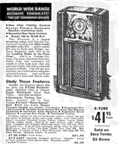

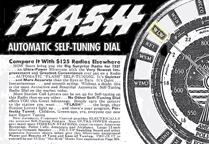
Silvertone M-4485 Console Radio
(right) "Flash Tuning" was available only on high end models
Neither the 4485 nor the 4486 had this feature
$41.95 in 1937 is equivalent to $1,250 in 2009 dollars
Click to Enlarge
In 1937, high end Silvertone receivers used a "flash" dial. The tuning eye was gone, and stations were marhked on the dial. As shown above, when the indicator was placed over the station name, automatic frequency control would take over and the station call letters would light up. All of this involved tedious pre-setting by technicians; "Flash" tuning did not survive for long due to complications and cost.
Click here to look at another type of collectible.
Sears Silvertone M-4486 Table Radio [ca 1937]
The M4486 is about the same as the 4485 except that it has 10 tubes and a 10 inch speaker.
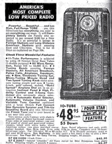


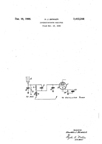
1937 Sears Silvertone M-4486 Console Radio
(middle) The "Two-speed Dial"
Patent No. 2,412,244 for the Superheterodyne Circuit
$48.95 in 1937 is equivalent to $1,500 in 2009 dollars
Click to Enlarge
Click here if you want to learn how to get Free Patent Drawings
A photo of the "Two-Speed" Dial is shown. I have used this system and it works just fine.
Prior to 1937, Sears was careful to point out that Silvertone Radios were manufactured under a superheterodyne circuit patented by RCA. This year marks the use of an independently patented circuit developed by Colonial Radios.
Click here to look at another type of collectible.
Sears Model M-6337 AKA R-301 AKA "Concert Grand" [ca 1939]
This is a 1939 Sears venture into the upper price territory - a 13 tube pushbutton-tuner radio that received on seven bands. It even had a plug-in jack for a television (!) or a phonograph. This was definitely a Big Deal and it was priced to match - $68.95, a figure that is equivalent to $2,100 in 2009. This was definitely a big purchase and it offered the same promise of unlimited entertainment that is used to sell Home Theater Systems in the 21st Century.

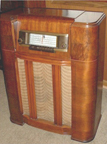

M-6337 (aka R-301)
The price is about a month's wages for a working man in 1939
Click to Enlarge
The ad takes pains to point out that "... when television comes, you will be ready for it ..." Since the actual bandwidth that TV would be transmitted on was subject to uncertainty, the ad also notes that the set "... has provision for plugging in an adapter..."
This set had nine illuminated push buttons. Six were reserved for "favorite" stations, two are for tone control and one is a switch to the auxiliary jack (Marked "phono/television"). It should be noted that the pushbuttons could only be set by a trained serviceman.
The tuner employed "super spread" bands for the foreign shortwave bands. Effectively, the 5.8 to 15.3 MC was split into four parts. This was advantageous because many international stations were grouped together -- spreading out the band made it easier to tune individual stations.
Click here to look at another type of collectible.
Sears Silvertone M-4766 Table Radio [ca 1938]
This 1938 table set offered a tuning dial that looked like a telephone dial (hence the name teledial. This was an early precursor to push buttons. The dial had to be set by a factory-trained serviceman, but Sears graciously provides "... call letter stickers for ALL American stations ..."
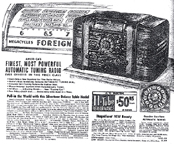
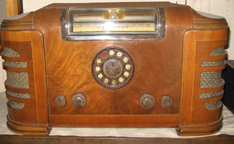
The Silvertone Model M-4766 Teledial Rable Radio
$50.45 in 1938 would be equivalent to $1,560 in 2009 dollars
Click to Enlarge
The 11 tube radio was housed in a cabinet featuring "... Exquisitley grained stump and walnut veneers used in the one-piece front and top panel with bands of stripe walnut..."
Click here to look at another type of collectible.
The Sears Silvertone Model M4688 Console Radio [ca 1938]
".. Just press the button lightly..radio tunes itself..." begins the ad for the top of the line Silvertone radio for 1938. In fact, automatic tuning with electronic frequency control was all the rage at the time. The pushbuttons had to be set by a factory-trained representative. Foreign stations were bunched together on the megacycle shortwave band and hard to tune. To this purpose, the m-4688 used a 70:1 gear ratio to move the indicator VERY slowly across the dial. As an additional aid to tuning, an illuminated display was placed on top of the receiver. As you can see in the photo below, graphics were effectively used to enhance the drama of listening to police calls, aircraft traffic and broadcasts from afar. Unsettled conditions in Europe gave much greater import to these international broadcasts.
Sears used some sort of legerdemain to squeeze an extra "tube" out of their radio -- the M-4688 had 14 real tubes, but was advertised as having "15 Tube Performance."
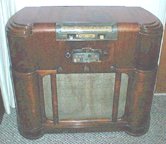
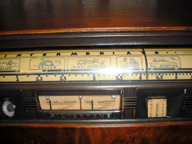
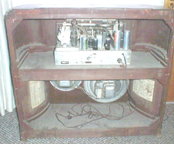
Silvertone M-4688 Console Radio
Automatic Motorized Tuning came at a price...
$94.75 in 1938 would be equivalent to $2,400 in 2009
Click to Enlarge
The ad suggests that parents should consider this radio "... one of the greatest investments that can be made for yourselves and your children ..." Once again, stump walnut veneer was extensively used over the plywood carcass of the set.
Click here to look at another type of collectible.
The Silvertone Model M-4685 Console Radio [ca 1938]
In contrast to the Model 4688, the Model 4685 was the bottom of the console price line. It does not have automatic tuning, but it does feature the "tuning eye" that had (by 1938) become sort of an anachronism.
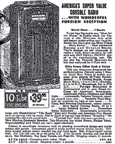

The Silvertone Model M-4685 Console Radio
$39.95 in 1938 is equivalent to $1,240 in 2009
Click to Enlarge
Even though this is the bottom of the line, the Silvertone cabinetmakers managed to find some "stump walnut" left over to decorate the cabinet.
Click here to look at another type of collectible.
The Silvertone Model 4687 Console Radio [ca 1939]
This radio is simply the M-4766 in a console cabinet. It shares all the same features as the 4766 with a bigger speaker
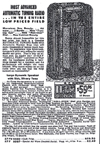
![The Silvertone Model 4687 Console Radio [ca 1939]](furn/Silvertone_4687_sm.jpg)
The Silvertone Model 4687 Console Radio
$59.95 in 1938 is equivalent to $1,860 in 2009
Click to Enlarge
Comparing the 4766 and 4687, it appears that the value of the bigger speaker and larger cabinet was about $9.50 in 1938 (about $130 in 2009 dollars).
Click here to look at another type of collectible.
Facsimile Transmission Circa 1939

The Crosley Radio Printer
From the May, 1939 issue of Popular Mechanics $50 in 1938 is equivalent to $2,000 in 2011
Click to Enlarge


The Crosley Radio Printer
(left)Do-it-yourself Kit
Finch Patent for the Radio Printer No. 1,985,654
Click to Enlarge
The printer came with two-layer paper, white on top, black underneath. The stylus cut away the white part to expose the black. This was wireless, so the rate of communication was only limited by the stylus at the end, not in transmission. It must have "buzzed" a lot while it was cutting the paper.
Hearing Aids
I have lost a whole lot of my natural hearing, so I must use technology to compensate for this loss. I have a drawer full of VERY EXPENSIVE hearing aids and I can assure you that they are simply annoying. A lot of my friends believe that hearing aids are like glasses -- that is, the minute you put them in, your hearing is magically fixed. That is not at all the case -- the minute you putthem in, the world sounds like it is coming from a very tinny old transistor radio.
Since this is probably being read in 2050 or beyond, it will suffice to say that in the 1950s, small radios that used solid state amplification were popular. Because they operated on low power, they had small speakers and thus the sound was faint with almost no bass -- hence "tinny".
In 2050, they will probably have developed a pill that will restore hearing, so this discussion may be really boring.My hearing aids are "reasonably small" meaning that if I move quickly enough and people look at my feet, they are hardly detectable. This was not the case in the 1930s.
![build-it-yourself hearing aids[ca 1938]](furn/hearing_aid_popmex051938_sm.jpg)
Do-It-Yourself Hearing Aid
From the May, 1938 issue of Popular Mechanics
Click to Enlarge
Note that the thing was "portable" -- and that you could build it yourself.
Here is an advertsiemnt for a commercial hearing aid that could be "custom-fitted" for the owner.
![Ad for custom-fit Hearing Aids[ca 1939]](enviro/custom_fit_Popmex051936_sm.jpg)
"Custom-Fit" Hearing Aid
The "Electro-Ear" Company...
From the May, 1936 issue of Popular Mechanics
Click to Enlarge
Vintage Radio Ads
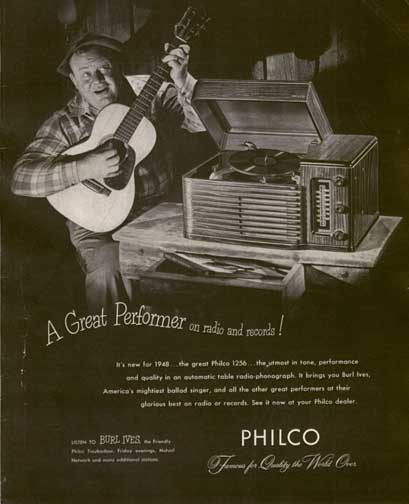
1941 Advertisement for the Philco 1256

1941 Advertisement for the Crosley line of radios
Counter for the Entire Website - not just this page
Home | About Lindy | 1940s Collectibles | Upcoming Events | Vintage Clothes
The Guide - Establishments - Travel - Accessories
Music | Links | Photo Gallery | Extras | Contact